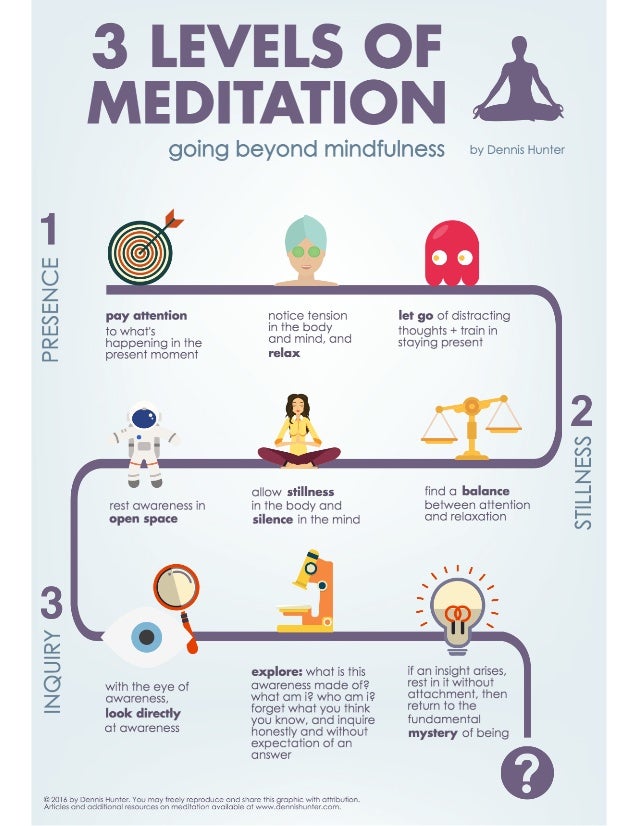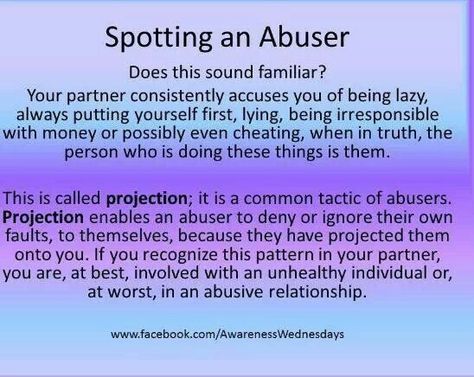Mind awareness meditation
A Meditation for Resting In Awareness
We have all tasted the “boundarylessness” of awareness on those occasions when we were able to suspend our own point of view momentarily and see from another person’s point of view and feel with him or her. We call this feeling empathy.
If we are too self-absorbed and caught up in our own experience in any moment, we will be unable to shift our perspective in this way and won’t even think to try. When we are self-preoccupied, there is virtually no awareness of whole domains of reality we may be living, immersed in every day but which nevertheless are continually impinging on and influencing our lives. Our emotions, and particularly the intensely afflictive emotions that “sweep us away,” such as anger, fear, and sadness, can all too easily blind us to the full picture of what is actually happening with others and within ourselves.
A Guided Meditation for Resting In Awareness
A Guided Meditation for Resting In Awareness
- 29:48
Through our practice of mindfulness, we have been cultivating an awareness that can become more and more stable and vivid, especially the more we practice with wise effort and intentionality. And this awareness can be either narrow or broad, depending on the circumstances it can recognize and embrace any and all sensations within the body, including the breath sensations. It can recognize and embrace seeing, hearing, smelling, tasting and touching, as well as those activities of mind we call thinking and feeling, and it can rest in a non-conceptual direct knowing of any or all of these aspects of human experience, beyond thinking, without separation or identification.
Or if on occasion we fall into identification and separation into a subject—a me—and the objects I am observing, either inwardly or outwardly, then awareness is capable of recognizing that as well and re-establishing the knowing itself, beyond any separation, beyond any identification, beyond the personal pronouns, beyond I, me, or mine, beyond thinking altogether. So the final expansion, if you will, within this framework is to abandon the framework. In the sense that we no longer choose a focus for awareness, but allow the field of awareness to be boundless. Since awareness actually is, and always has been boundless.
Since awareness actually is, and always has been boundless.
We no longer choose a focus for awareness, but allow the field of awareness to be boundless. Since awareness actually is, and always has been boundless.
But as we know from our own efforts, in minds that have not encountered training and mindfulness, awareness does tend to contract and nucleate around particular arisings, especially events that have emotional charge for us. And then it tends to fixate and either be very narrow, or very self interested and self centered. Or on the other hand, to fall into utter rebellion. In other words, no awareness at all, merely obsession or dullness.
So in this moment, resting in awareness, perhaps at first allowing the field of awareness to feature the soundscape, which is as we have experienced over and over again, always here, presenting itself to our ears comprising everything that presents itself in the form of sound and the spaces between sounds. Everything, without exception. So resting in hearing, being the hearing, without necessarily creating any distance between a you and what is being heard. But simply hearing. Being the hearing. Being the hearing right now, in this moment.
Everything, without exception. So resting in hearing, being the hearing, without necessarily creating any distance between a you and what is being heard. But simply hearing. Being the hearing. Being the hearing right now, in this moment.
And of course if there are thoughts that make their way in, letting them be known because awareness can include the knowing of thought. And expanding the field of awareness whenever you care to, to include the air caressing the skin, the air that is the breath, the air that carries sound, and resting in the knowing of the air and the breath again through the sensations in the body, since it is only through the senses, including mind, that we can know anything. And we can naturally allow a field of awareness to include of course, not just the sensations associated with breathing or the touch of the air on the skin, but any sensations and all sensations in the body right here as we sit.
And so in this moment, with the field of awareness expanded this far, we have sounds and the spaces between sounds, we have the breath and we have the air, and we have sensations in the body. That’s a lot, and it is all happening in this one moment. And it’s not separate, although we can isolate any feature of it. So just allowing it all to be present without separation in this moment, and to rest in awareness of the experiencing of it, of it all. Sitting, breathing, feeling, hearing, knowing and why exclude thinking, since it’s going on anyway. So allowing the field of awareness to expand even further to include thought, the thought stream, the bubbles of thought. And any emotional currents, eddies or whirlpools that may arise in the mind or in the heart, accompanied or unaccompanied by images and thoughts, memories or fantasies. And just allowing ourselves to rest in this awareness, this bigger basket that holds it all.
That’s a lot, and it is all happening in this one moment. And it’s not separate, although we can isolate any feature of it. So just allowing it all to be present without separation in this moment, and to rest in awareness of the experiencing of it, of it all. Sitting, breathing, feeling, hearing, knowing and why exclude thinking, since it’s going on anyway. So allowing the field of awareness to expand even further to include thought, the thought stream, the bubbles of thought. And any emotional currents, eddies or whirlpools that may arise in the mind or in the heart, accompanied or unaccompanied by images and thoughts, memories or fantasies. And just allowing ourselves to rest in this awareness, this bigger basket that holds it all.
And now in one last jump, let’s allow the field of awareness to expand infinitely to allow the mind, heart to be boundless, hugely spacious, as big as the sky or space itself, with no beginning and no end, no boundary, no circumference, no periphery.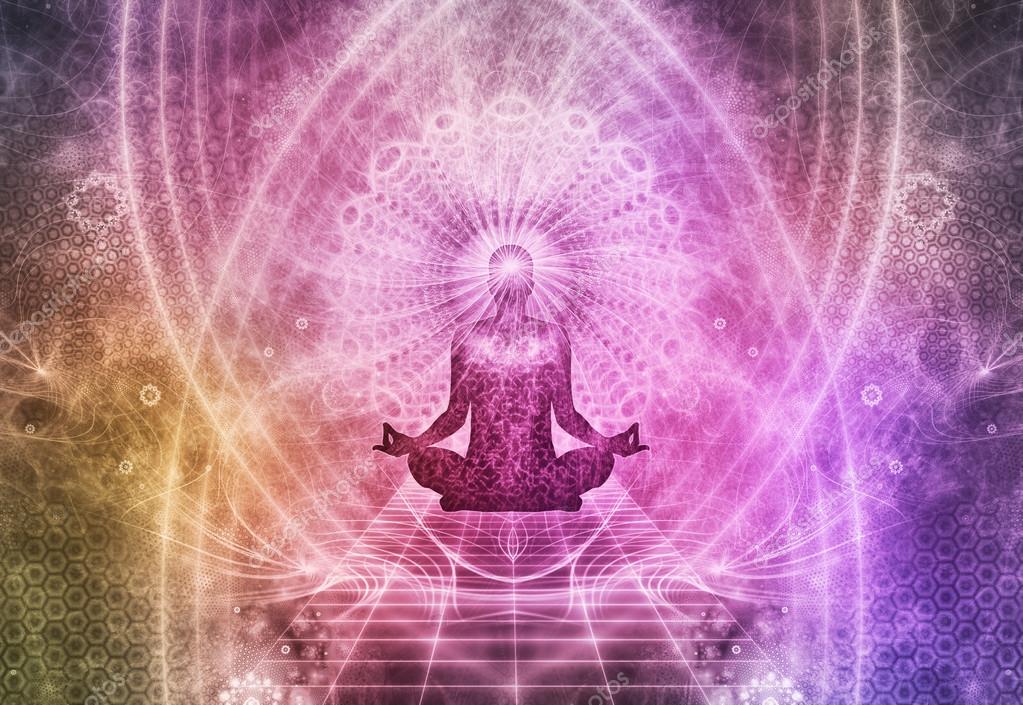 No center. And rather than focusing on anything in particular, just allowing the quality of our awareness to be choiceless. To rest in the non-conceptual knowing quality of mind itself. Not seeking out anything, not pursuing anything, not rejecting anything and not featuring anything, but like an electromagnetic field so to speak, that would instantly know any perturbation any movement whatsoever that would arise within it.
No center. And rather than focusing on anything in particular, just allowing the quality of our awareness to be choiceless. To rest in the non-conceptual knowing quality of mind itself. Not seeking out anything, not pursuing anything, not rejecting anything and not featuring anything, but like an electromagnetic field so to speak, that would instantly know any perturbation any movement whatsoever that would arise within it.
So the field of awareness, like a mirror but in many more dimensions knows, detects, feels sees and senses whatever moves, whatever arises, whatever it lingers, whatever dissolves. So resting in awareness itself, in the choiceless, boundless, vast, spacious quality of awareness itself. If sound predominates in some moment, then sound is known. If the thought follows on the sound, then the thought is known as thinking now. Conceptually it’s recognized, known, felt neither pushed away nor pursued, neither condemned nor extolled.
If in the next moment the sensation arises in your lower back or in your knee and predominates in the field of awareness for a moment, that is also felt, seen, known and neither pushed away nor pursued, condemned nor extolled.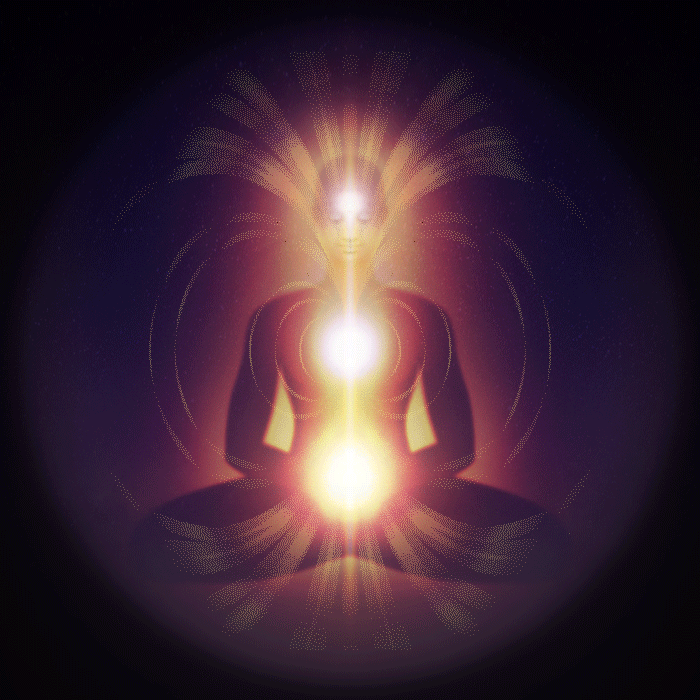 Awareness functions an open, empty, spacious mirror, empty and full, able to contain anything and needing nothing to complete itself. Undisturbed, imperturbable, never not here. Like the sun always shining even when clouds obscure it. And even if we become irritated or vexed, this boundless and accepting field of awareness embraces irritation and vexation, grief, joy. Anything and everything: pain, discomfort, agitation, boredom, depression, sadness.
Awareness functions an open, empty, spacious mirror, empty and full, able to contain anything and needing nothing to complete itself. Undisturbed, imperturbable, never not here. Like the sun always shining even when clouds obscure it. And even if we become irritated or vexed, this boundless and accepting field of awareness embraces irritation and vexation, grief, joy. Anything and everything: pain, discomfort, agitation, boredom, depression, sadness.
Awareness functions as an open, spacious mirror, empty and full, able to contain anything and needing nothing to complete itself.
There is no mind-state and no body-state that can’t be held seen, felt, known, in this infinite, boundless spaciousness. This knowing quality of the heart, mind resting in its natural luminosity and radiance with nowhere to go, nothing to do, nothing to attain, no choices to make. And no one to make them sometimes.
This is known in the Chinese tradition as silent illumination, with the method of no method.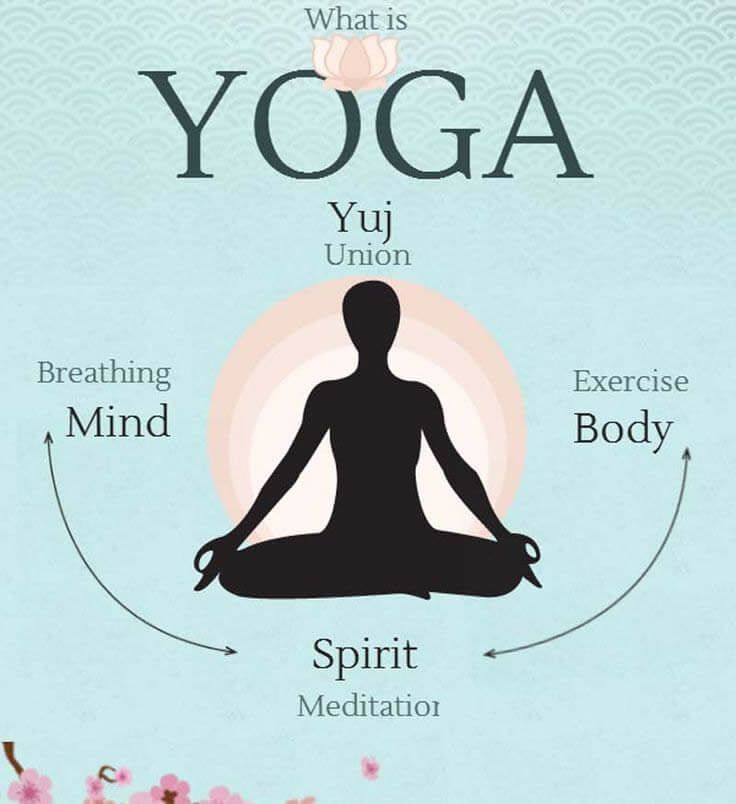 Nothing missing, nothing extra, resting in this choiceless awareness that the Tibetans sometimes call non-meditation, when all the scaffolding falls away. They don’t call it meditation anymore, they call it non-meditation but it’s got a few adjectives that make it more precise. And demonstrate how challenging it is they refer to it as undistracted and fabricated non meditation just this moment, seen and known as it is by this boundless spaciousness. This all inclusive knowing that is truly what distinguishes us as human so is best you can. With effortless effort, resting in choiceless awareness.
Nothing missing, nothing extra, resting in this choiceless awareness that the Tibetans sometimes call non-meditation, when all the scaffolding falls away. They don’t call it meditation anymore, they call it non-meditation but it’s got a few adjectives that make it more precise. And demonstrate how challenging it is they refer to it as undistracted and fabricated non meditation just this moment, seen and known as it is by this boundless spaciousness. This all inclusive knowing that is truly what distinguishes us as human so is best you can. With effortless effort, resting in choiceless awareness.
If thoughts arise, they are met with mindfulness, seen and known in their arising like bubbles coming off the bottom of a pot. They just burst on their own. The Tibetans refer to this as self liberation the thoughts self liberate nice way to put it you don’t have to do anything just resting in awareness just attending with sounds sensations impulses perception’s thoughts emotions all coming and going in this fast benign kind compassionate, accepting and inclusive spaciousness, with no center, no periphery, no agenda, no preferences, no watcher, no words at all. Just this.
Just this.
Of course if you get lost in the just this and that can happen very very easily. That may be featuring some object or other letting the field of awareness narrowed down reestablishing the stability of mind and then allowing it to expand out again to whatever degree you like either stepwise in the way that we’ve just done or jumping straight to choiceless awareness, because the awareness is never not here, it’s always available. And we’re beyond time, space, liking and disliking, meditating and not meditating. Just the wake of vast open field of heart-full awareness, resting here, nothing happening, nothing special. Simply life expressing itself and knowing it, and in the remaining few moments of this sitting if you care to coming back to the breath, letting go of the vast spaciousness for a moment and featuring the breath once again or the breath in the body, the body as a whole sitting here breathing, or anything else that you care to feature. Or if you care to simply continue dwelling in choiceless awareness, then of course. And in the spirit of this practice, it’s your choiceless choice.
And in the spirit of this practice, it’s your choiceless choice.
Resting here until the sound of the bells signals the end of this period of formal practice, and keeping in mind that this pristine open spaciousness of heart and mind is available to you in any and every moment of your life, unfolding now first separate from you and inhabitable. As you cultivate ongoing awareness in your daily life through the practice of mindfulness. And as you commit yourself, if you care to, if it makes sense to, using the regular discipline of formal mindfulness practice, a commitment that is tantamount to giving yourself over and over again to the adventure of a lifetime, to the cultivation of wakefulness. For the sake of being free from the anguish, of unnecessary suffering from afflictive emotions. From ignoring what is most fundamental to life and for the sake of embracing with loving kindness and compassion and wisdom. All beings including, yourself who are living and breathing, and sometimes suffering in this mysterious and awe inspiring world we find ourselves in.
The above is adapted from Jon Kabat-Zinn’s Guided Mindfulness Meditation Series 3, available here. These guided meditations are designed to accompany Jon Kabat-Zinn’s book Meditation is Not What You Think and the other three volumes based on Coming to Our Senses.
Meditation for awareness - Headspace
Every time we meditate, we are training in awareness. But what does “awareness” actually mean? This is a deep question. Becoming aware of our awareness is not straightforward, mainly because the untrained mind likes to latch on to whatever object or sight it sees, or whatever thought, emotion, or sensation that arises; in short, whatever we perceive.
When we step away from all of this — without ideas, judgment, inner-dialogue, or the need to define — we step into a space of awareness; a space where we merely observe how the mind behaves, and where we experience the present moment . .. without thinking, without distraction.
.. without thinking, without distraction.
We meditate to develop a stable awareness over time, to the extent that we are not so easily caught up in, or thrown by, thoughts and emotions. Headspace co-founder Andy Puddicombe says there is ultimately only awareness or non-awareness. Or, to put it another way, distractedness or non-distractedness.
When in a state of awareness, we’re able to zoom out and observe the mind “a little like looking at the earth from the moon,” says Andy. Awareness affords us a whole new perspective, and through this perspective, we gain a whole new understanding. By practicing awareness — not identifying with what we think, what we feel, what we believe, or what we know — we get to create a spaciousness of mind that sets us free from the impact of our thoughts and feelings; it allows us to be more at ease with the moment-to-moment unfolding of life itself.
Sure, but I still don’t totally get what awareness is ...
Dr. David Cox of the National Health Service likes to use a simple analogy to explain awareness versus non-awareness. “Imagine watching a horror movie alone, at home, with the lights off,” he says. “The movie owns you. It’s terrifying. It’s all you’re aware of and so it has complete control over your emotions.” Similarly, when you’re experiencing thoughts in a state of non-awareness, they can be scary and all-consuming.
“Imagine watching a horror movie alone, at home, with the lights off,” he says. “The movie owns you. It’s terrifying. It’s all you’re aware of and so it has complete control over your emotions.” Similarly, when you’re experiencing thoughts in a state of non-awareness, they can be scary and all-consuming.
In contrast, awareness is like watching that same scary movie by yourself, but this time with the lights on. “With the lights on, you have more context,” explains Dr. Cox. You can see that the movie is in fact just a movie playing on TV, and that there are other things around you like your dog and your favorite pillow. “It’s still scary, but it’s not as bad as it is with the lights off because you have a bit more perspective.”
Another way to frame awareness, as suggested in this Headspace article, is to think of small mind, big mind. “Small mind” describes the thinking mind — our intellect, our analysis, our decision-making — but that same mind is prone to being easily distracted or overwhelmed. “Big mind” on the other hand steps into a spaciousness that sees, acknowledges, then lets go of thoughts, emotions, and sensations without involvement.
“Big mind” on the other hand steps into a spaciousness that sees, acknowledges, then lets go of thoughts, emotions, and sensations without involvement.
How do you practice meditation for awareness?
Meditation helps us train in two types of awareness: awareness with an object of focus, and awareness without an object. When we refer to awareness with an object of focus, that might mean resting our attention on the breath; each time the mind wanders, we simply bring the attention back to the breath — and our awareness is restored. The breath acts as our anchor to the present moment.
Awareness without an object is a little tougher, and probably for more seasoned meditators, because we are asking the mind to rest in awareness itself, without focusing on anything. We are just present with the silence and quality of spaciousness.
Through practicing meditation, we’re able to train the mind to expand the amount of time it can rest in awareness. But is all this effort worth it? Yes, because an awareness of thoughts and feelings, and a better understanding of why we think and feel the way we do, allows for more choice in your responses and actions, which in turn, leads to reduced stress, increased happiness, improved relationships, and an overall richer existence.
Watch this one-minute video to learn more about the awareness technique.
## What’s self-awareness meditation?
When we use meditation to look inward and gain insight into our thought patterns, we are practicing meditation for self-awareness. Psychologist and author Tasha Eurich describes self-awareness as “the ability to see ourselves clearly — to understand who we are, how others see us, and how we fit into the world around us.”
One positive side effect of practicing awareness meditation is that we begin to see ourselves more clearly through the process. By quieting the noise and witnessing our thoughts without judgment or inner commentary, we can become more intimate with ourselves, our needs, our desires, and our limitations. With this self-knowledge comes the ability to make smarter choices that positively impact our lives and our world. According to Eurich, “There is strong scientific evidence that people who know themselves and how others see them are happier. ”
”
Jeda Mali - awareness in the present moment. Mindfulness meditation. Implementation details
For thousands of years meditation has been used to help the body, mind and spirit expand the existing boundaries of consciousness. Today, meditation is recognized as a stress reliever, it helps lower blood pressure, reduces the effects of negative emotions, and calms the mind. As Deepak Chopra likes to point out, "Meditation is not a way to quiet your mind. It's a way to release inner peace and quiet." What are the benefits of meditating people?
1. They are much happier
Psychologists believe that meditation increases positive emotions, reduces negative ones, and strengthens the mechanisms of survival and self-preservation. Meditation is one of the tools that some schools and employers are using to improve the well-being of students and employees.
2. They see the world from a creative side
People who meditate regularly report feeling great creativity and a sense of "direct download" from the universe after meditating. Where was the song before the composer wrote it? Where was dance before the choreographer invented it? While scientists cannot find scientific answers to these questions, we do know that people who meditate experience increased creativity and innovative ideas.
Where was the song before the composer wrote it? Where was dance before the choreographer invented it? While scientists cannot find scientific answers to these questions, we do know that people who meditate experience increased creativity and innovative ideas.
3. They are closely related to each other
When people meditate, they seem to be temporarily isolated from the whole world, being alone with their inner energy, but one of the paradoxes of meditation is that by spending time with themselves, they feel a greater sense of connection with others. They often unite in groups for deeper practices, and they also feel unity with all people, perceiving them as brothers and sisters or as a piece of the divine in every manifested being.
4. They let go easily
Such people do not hold resentment, fear or pain in themselves. By spending time thinking, they use their useful ability to be compassionate and empathetic, and spend less time critically self-flagellation and value judgment of others.
5. They are less sensitive to pain
When people who experienced chronic pain due to illness were taught meditation, they reported a reduction in pain and an increase in tolerance to it. Meditation actually changes the brain and teaches it to masterfully generate positive emotions on its own.
6. They are more resistant
People who meditate have a healthier response to stress than non-meditators. Brain scans of meditators show that they use different parts of the brain to deal with stressful situations than other people. Sitting silently for a few minutes every day actually means to change the density of gray matter in the right and left hemispheres. This means that when things go wrong, our brain is better able to come up with its own way out of the situation and cope with stress. This will increase many skills needed for self-preservation.
7. They are guided by intuition
People who meditate for a long time notice that their inner voice, intuition, is more developed than other people. Accordingly, they learn to trust themselves and intuitively make the right decisions that positively affect their destiny.
Accordingly, they learn to trust themselves and intuitively make the right decisions that positively affect their destiny.
8. They accept everything as it is
Meditators learn to accept everything good and bad that comes into their lives with gratitude or at least acceptance. They note that everything is relative, so you should not divide into black and white, bad and good. They do not ask: "What is it for me, why am I, etc.", they rather reflect on the question "Why am I here, what does the Universe want me to do, etc."
9. They easily accept change
Nothing is permanent in life, especially in the lives of meditators. By meditating, they change from within, which means they change the world around them. Changes only mean movement, and we must strive for this movement to be forward or upward, but not backward (degradation).
10. They know the meaning of life
Being engaged in spirituality and meditation, meaning appears in their life, they know what their soul aspires to and what needs to be done for their own realization. Therefore, their life is more full and harmonious
Therefore, their life is more full and harmonious
I once heard that daily meditation significantly improves the quality of life in the first 2 months. I have often come across information that many successful people start their day with a ten-minute meditation.
When I wanted to know better what meditation is and how to learn it from scratch, I read the book Concentration and Meditation by Swami Sivananda. This is an impressive work of the world-respected Indian yogi. I read the whole book with interest, but did I understand what meditation is? No.
It takes practice to learn meditation. Therefore, first carefully read the article, and then proceed to practice.
Imagine that someone would describe in three volumes the taste of honey. Would anyone reading this book be able to recognize the taste of honey if they had never tasted it before? The taste of honey is a very simple thing, yet it is impossible to describe it. You can only get this experience.
Similarly, it is impossible to describe the state of meditation or the state of liberation from the mind. This is a very simple thing, but it takes practice and experience. And then no books and no theory will be needed anymore. You will simply enjoy the taste of meditation.
However, the theoretical instructions can serve as a kind of navigator, indicating the path to the desired state. If you have no idea what honey is but want to try it, you can walk into a store and stand confused in the middle of the sales area, not knowing which department to go to. But store employees will easily point you to a shelf with jars of honey. And if you decide to get it yourself and build an apiary on your site, you will need more complicated instructions.
There is nothing magical about meditation. Meditation is a simple exercise to train your ability to control your attention.
There are two main ways of meditation.
- Concentration of attention on one object: internal or external.
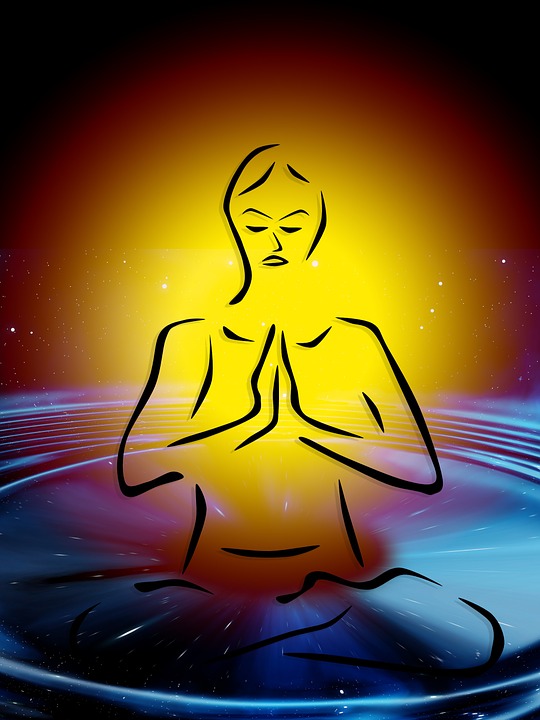
- Observing what is happening in the present moment without allowing attention to get stuck on anything in particular (streaming state of consciousness).
Meditation is an individual practice, although it is often practiced in groups. Usually the practitioner sits in a fixed posture with a straight back. But you can practice meditation in motion or lying down. It's just that a sitting posture with a straight back is easier to concentrate, so this position is recommended at the beginning of training.
In fact, the word "meditation" is translated from Latin as "reflection". But when the Eastern practices of self-improvement began to penetrate the West, the word meditation began to refer to all the techniques of working with consciousness. Such as Japanese Zen, Chinese Chan, Vietnamese Thien, Yogic Dhyana. It is customary for us to combine all these practices of developing the mind and training attention with one word “meditation”.
To be fair, I want to note that not only the process is called meditation, but also the final result of this process, that is, the achieved state of peace can be called meditation.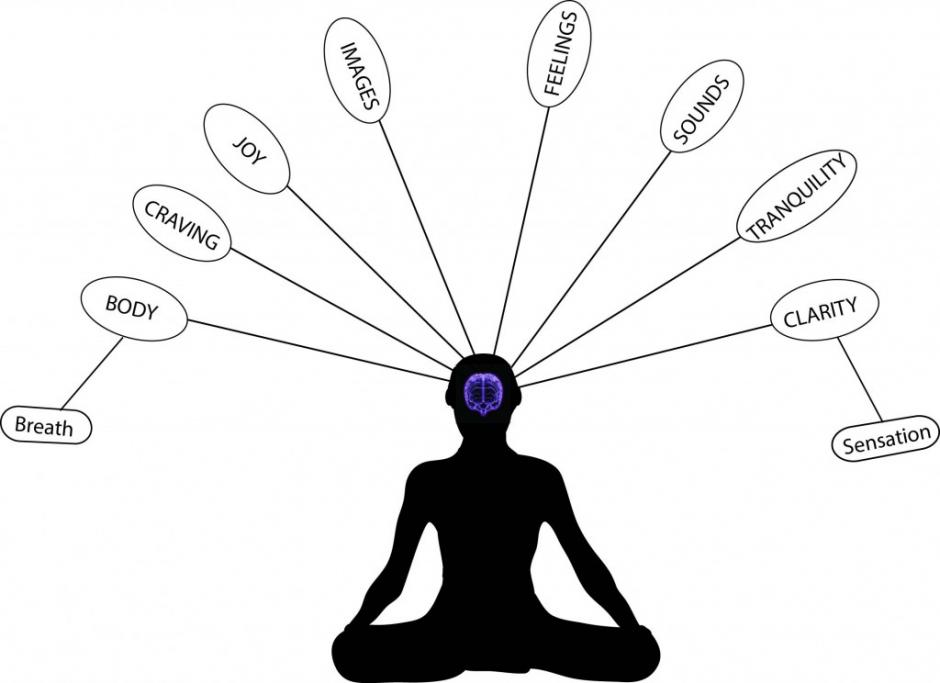
How often do you find yourself thinking that you want to take a break from constant anxiety and fatigue? Many people feel that they need to dive into an ocean of calmness in order to restore vitality and clarity of mind. Meditation is the best remedy for this. You can learn meditation from scratch in a few minutes. Let's take a closer look at what meditation is, and then move on to practical exercises.
Meditation is the art of achieving inner peace. When the long-awaited silence comes inside, the mind calms down, and the body relaxes, a powerful reboot of the psyche occurs. Just a few minutes of this state a day effectively contributes to the improvement of the body, normalization of pressure and heart rate.
5 myths about meditation
Actually, there are several opinions about what meditation is. What is not called by this word. Here are some common misconceptions.
- Meditation is a ritual to attract money, love and other blessings
- Meditation is something in the realm of religion
- Meditation is something related to sects
- Meditation is long-term asceticism and withdrawal from society
- Meditation is a difficult, boring and useless activity
I find it wrong to associate meditation with magic or mysticism.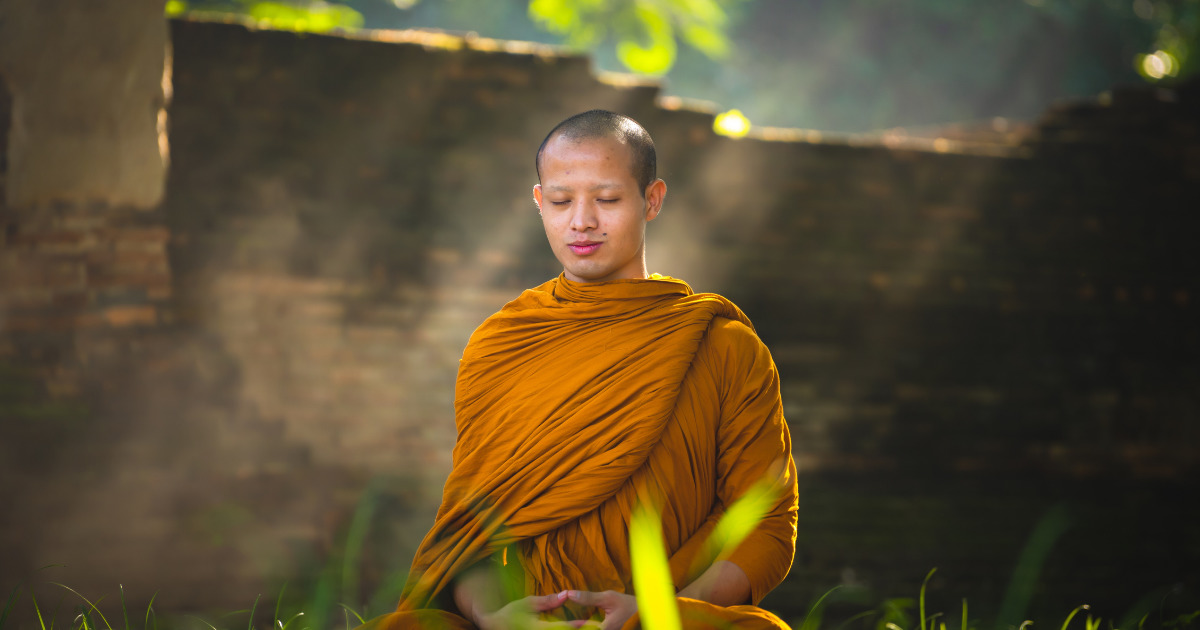 My approach to meditation is not sectarian and has nothing to do with "secret knowledge".
My approach to meditation is not sectarian and has nothing to do with "secret knowledge".
Meditation for me is a practical psychological tool for developing my mind. The practice of meditation gives a clear mind, trains concentration, creates conditions for the development of inner peace. All these qualities contribute to the improvement of health and success in ordinary earthly affairs, work, family.
In this article I will tell you what meditation is and show you how to learn it. Also at the end I will give simple exercises for beginners, which you can start practicing today.
Why should one meditate?
If you look closely, you will notice that all our actions have only two reasons: an attempt to alleviate suffering and the desire to receive pleasure. The absence of pain and the presence of pleasure is what we call happiness.
Sometimes it's interesting to catch yourself in any action during the day and ask yourself the question: why am I doing this? If at this moment you, for example, are preparing yourself a sandwich for breakfast, ask yourself: “Why am I making this sandwich?”. The answer will be related to getting rid of hunger and enjoying delicious food.
The answer will be related to getting rid of hunger and enjoying delicious food.
Similarly, the reasons why we want to meditate will be some variation on getting rid of suffering and getting pleasure.
Meditation gives a person strength. First of all, during meditation, the ability to concentrate consciousness develops. A concentrated mind is able to quickly find solutions to complex problems. The ability to concentrate the will contributes to effective actions. Inner peace will help you everywhere: at business meetings, on the sports ground, on stage and at home with your family.
I think we all have negative thoughts and feelings that haunt us all our lives. With reason, we understand that there is no sense in them, you can get rid of them, and it will only get better. But we cannot do this. These include irrational fears, bad habits, despondency or depression.
From this we can conclude that our mind is not always our best friend. And sometimes it's better not to follow his lead, but to learn how to manage it. Who controls your attention? Do you manage it yourself or does it walk by itself like a lamb that escaped from a paddock?
Who controls your attention? Do you manage it yourself or does it walk by itself like a lamb that escaped from a paddock?
Try to sit for 10 minutes paying attention to your breathing. You will notice that your attention does not really listen to you. How many times have you caught yourself thinking about the past or worrying about the future? Don't worry, this is completely normal for an untrained person.
But such chaotic thoughts waste a lot of energy, cause unconscious tension in the body, and this in turn can be the cause of health problems.
Agree, feeling calm and relaxed is much better than worrying about every little thing. In addition, a relaxed healthy psyche is the key to health. Those of your illnesses that are caused by nervous tension, stress or resentment stuck ten years ago will go away with tension.
I am very glad that recently Western science has turned its attention to the beneficial properties of meditation. In general, meditation has become very popular in the United States in recent years. Of course, science does not recognize subtle energies and chakras, but it has been experimentally proven at least that meditation normalizes blood pressure and lowers the stress hormone cortisol.
Of course, science does not recognize subtle energies and chakras, but it has been experimentally proven at least that meditation normalizes blood pressure and lowers the stress hormone cortisol.
Monkey thoughts
When you sit down in meditation and turn your attention inward, you will surely encounter what Buddhism calls "monkey thoughts." Thoughts, images and emotions will bounce around like a bunch of excited monkeys jumping from branch to branch, each with its own agenda.
You may be surprised and a little discouraged when you find such chaos in your mind. Remember that such experiences are very common, almost all meditators experience something similar, at least at the beginning of their practice. Awareness and familiarity with "thought-monkeys" is an important first step.
If you pay more attention to observing this incoherent stream of thoughts, images and sensations, some patterns will become apparent. You will probably notice that most of these thoughts revolve around the past and the future.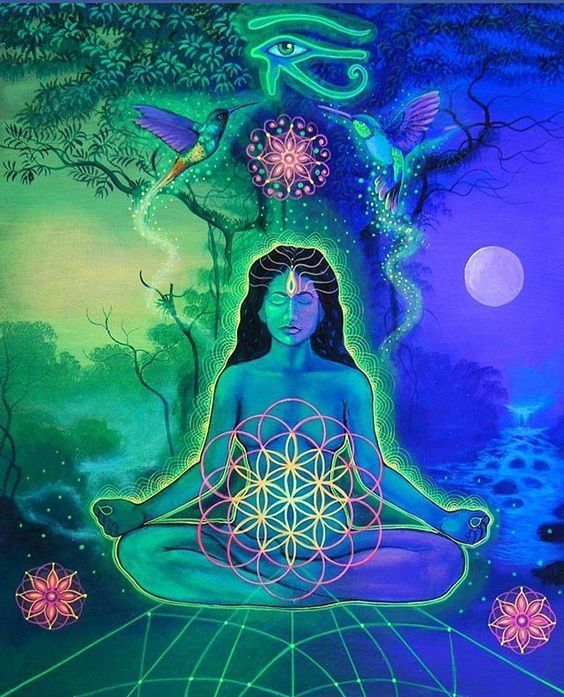
These are reflections, regrets and memories of the past mixed with fears, expectations and plans for the future. You may also find that a significant portion of the monkey's mind contains:
1) thinking about things you don't currently have but want to have and thinking about how to get them (e.g. a new car)
2) thinking about things you have but don't want to have and thinking about how to get rid of them (a hateful job you have to do every day).
Again, this is perfectly normal. You also need to understand that thoughts in and of themselves are not something bad. There are useful thoughts that are related to the implementation of practical tasks. For example, calculating the time of the road home and thinking about whether you will have time to go to the post office before closing.
There are creative and beautiful thoughts, for example, the thought process for home improvement, solving scientific problems, philosophical reflections on life.
There are pleasant and inspiring thoughts that support us, for example, the memory of a good deed that we have done or someone has done towards us.
There are thoughts useful for meditation, such as reminding you of instructions or counting your inhalations and exhalations.
But none of this has anything to do with monkey thoughts. Thought-monkeys are mental chatter that seems to be erratic, devoid of reason.
Thought-monkeys go around in circles like an endless replay of a bad movie. If you look closely, you will notice that some thoughts are repeated over and over again. Some of them can be helpful, but some are just obsessive-monkey thoughts. It is better to get rid of obsessive useless thoughts, making room for creative thinking or just silence.
How will meditation help?
Habitual thought patterns correspond to pathways in brain neural networks that have become deep grooves. Meditation helps to replace those old, boring ruts, those endlessly repetitive thoughts with new and fresh ways of thinking.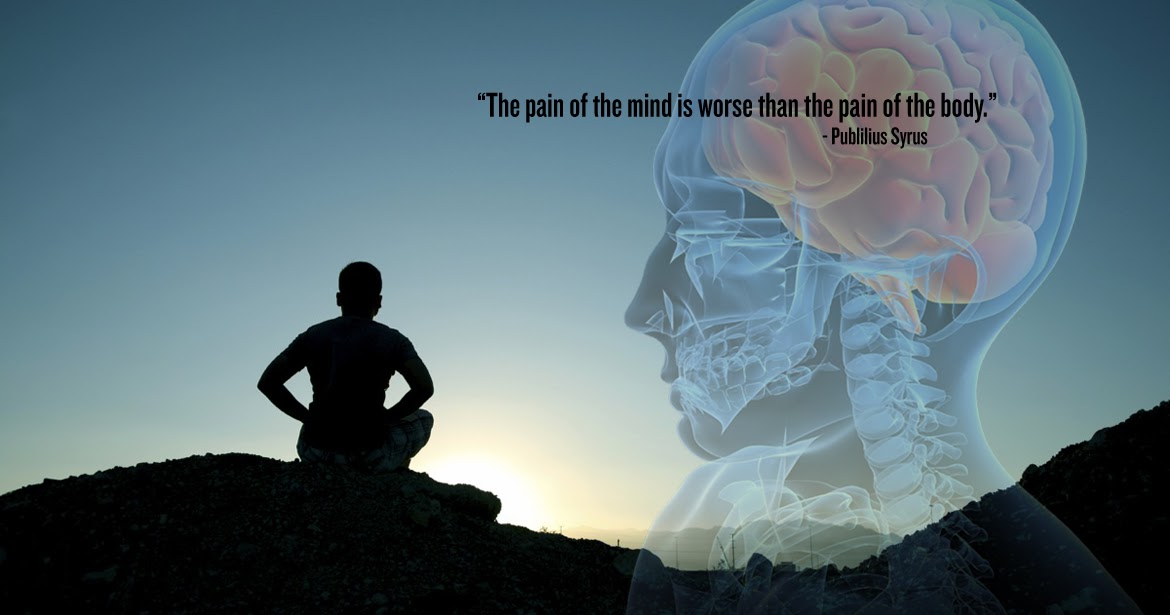
Think of it as a path through a grassy meadow. When the path is used frequently, it becomes deep and wide. But when not in use, it quickly overgrows with grass and blends into the rest of the field. Likewise, habitual thinking, such as judging people, dissolves when you start walking a different path. Meditation helps create these alternative paths.
See also:
How to learn meditation
Your beginning to learn meditation can be compared to going on vacation—let's say a two-week trip to Paris. In preparation for your trip, you create a general plan of where you will go and what you will see. You can also prepare maps and designate routes on how to get to the Eiffel Tower and see its surroundings.
Route and maps are useful things when traveling. However, the real joy comes from the direct experience of walking in Paris.
The real pleasure comes from the aroma of almond croissants in the morning patisserie where you have breakfast as the sun rises over the city as people of all ages pass by speaking languages you don't understand.
Joy comes from finding a field of sunflowers that you decide to wander around eating delicious almond croissants.
Joy comes from warm spontaneous conversations with your travel partner, mutual feelings and unexpected moments of intimacy.
The direct experience of having breakfast in a patisserie and walking through a sunflower field cannot be seen on a map. The specifics of this and any other experience cannot be foreseen by the itinerary. In fact, the true richness of life, that deepest pleasure, occurs the moment we put aside maps and routes, put aside our expectations, and fully immerse ourselves in what is really happening.
This is also true for the practice of meditation. The information space is littered with books and articles with meditation lessons. We have no shortage of instructions and maps. But the real experience happens when we put aside the study of theory and plunge into practice.
Exercises to help learn meditation
1. Observing what is happening
Observing what is happening
The easiest way to meditate is just to sit and do nothing. There is no need to focus on anything here. Just observe what is happening in the present moment without any effort.
Breathe naturally, as you are used to. Let the thoughts swirl in the mind, let the mind go where it wants to go. Remember that internal dialogue is a normal natural process for every person, do not suppress it. Do not control feelings, let feelings and thoughts come and go like the weather outside.
The task in this meditation is to observe the flow of thoughts and feelings without clinging to them. Just watch how they appear on the inner screen and how they disappear. Listen to the sounds around you without trying to dwell on them.
The present moment never stops. It is impossible to catch and hold in the mind, every moment is new. Before you become aware of what is happening now, you need to free your mind for the next awareness. Consciousness is constantly flowing, and you constantly keep your attention on its edge.
This meditation is called "mindfulness." Or, as it is commonly called in the West mindfulness - mindfulness.
Its usefulness cannot be overestimated. Scientific studies are being carried out confirming the normalization of pressure and the improvement of hormonal levels in people who practice mindfulness. But it is better to conduct such a study with yourself and see for yourself.
2. Concentration of attention on breathing
Another simple meditation. Sit with a straight back. You can sit us a chair, in the lotus position or the hero's position. The main thing is that the back is straight, as we need free breathing.
Concentrate on your breath. Watch your breath and be aware of it. First, you can direct attention to the tip of the nose, to how cool air passes through the nostrils, then how the air fills the lungs, how the diaphragm descends and the stomach inflates.
Then watch the exhalation as the respiratory muscles relax, pushing the air out.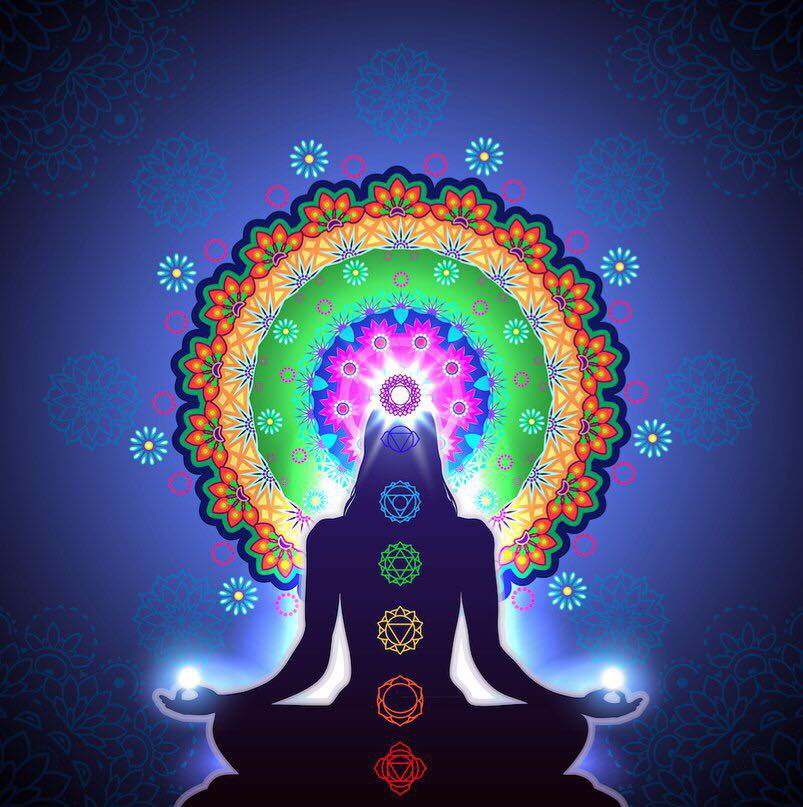 How warm air travels through the airways and how it feels at the tip of the nose.
How warm air travels through the airways and how it feels at the tip of the nose.
Count each exhalation. Take only 10 breaths. If you get lost, start again. When you notice that your attention has been distracted by extraneous thoughts, very gently, with a kind smile, return it to your breath. Never scold or blame yourself. This is a normal process of training and learning to meditate.
3. Mantra meditation
Our attention can only be directed to one object at a time. If you think you can think about several things at the same time, then it only seems to you. It's just that your attention switches very quickly between different objects.
This property of attention is used in mantra meditation. The essence of this meditation is that we occupy the internal dialogue with some kind of sound that does not carry any meaning. For example, the sound "ommm" or any mantra. In this way, we can stop the chaotic chatter of the mind and just calmly observe the mantra repeated in the mind. After a while, the desired state of rest sets in.
After a while, the desired state of rest sets in.
Here are some good meditation mantras:
- Om Mane Padme Hum
- Om Namah Shivaya
- Om Shanti Shanti Shanti
- Sat Chit Ananda
- Om Vajrapani Hum
- The body must be rested. It is better not to meditate after exhausting physical training. Also, meditation is much more effective in the morning after a good sleep, when you are not tired either physically or mentally.
- The mind must be alert. In the morning you need to find a suitable way to cheer up. For example, take a cool shower or do a simple physical workout. Three cycles of Sun Salutation from yoga will work well.
- The stomach must be empty. After a heavy meal, 2-3 hours should pass. After a light snack, wait 40 minutes before meditating. On an empty stomach, clarity of mind is easier to achieve, but, of course, you don’t need to starve yourself. Again, in the morning, while the appetite has not yet woken up, and eight hours have passed since the last meal - a good moment for meditation.

- Set your phone to silent mode so that nothing distracts you from your practice. Ask your loved ones not to disturb you, and try to negotiate with your pets to leave you alone for a few minutes.
- Do a couple of minutes of breathing exercises before practice, if you know any. This will help clear your mind and cheer you up.
- Put on loose clothing, remove accessories and jewellery. Breathing should be free, nothing should squeeze the body in the abdomen of the chest.
Output
One can only understand what meditation is and how to learn it from one's own experience. No books or articles can show this amazing feeling of lightness and liberation that meditation brings. Don't be afraid to try, don't be afraid that you are meditating the wrong way. The main thing is to start, and with experience you will learn this great art.
See you soon!
Your Rinat Zinatullin
When the Neuroscience Society invited Tenzin Gyatso (14th Dalai Lama) to its annual meeting in Washington in 2005, several hundred people among the 35,000 present demanded that the invitation be cancelled. They believed that there was no place for religious leaders in a scientific meeting. But it turned out that it was he who asked the audience a provocative and useful question. Tenzin Gyatso asked: "What is the connection between Buddhism, ancient Indian and religious-philosophical traditions and modern science?"
They believed that there was no place for religious leaders in a scientific meeting. But it turned out that it was he who asked the audience a provocative and useful question. Tenzin Gyatso asked: "What is the connection between Buddhism, ancient Indian and religious-philosophical traditions and modern science?"
Before starting the conversation, the Dalai Lama had already done some work to find an answer to this question. In the 1980s he initiated a discussion of the prospects for cooperation between science and Buddhism, which led to the creation of the Mind and Life Institute, aimed at studying the meditative sciences. In 2000, he set a new goal for the project, organizing the "Meditative Neuroscience" direction, and invited scientists to study the brain activity of Buddhists who are seriously involved in meditation and have more than 10 thousand hours of practice. Over the past 15 years, more than 100 Buddhists, monastics and lay people, as well as a large number of people who have recently started meditating, have participated in scientific experiments at the University of Wisconsin-Madison and in 19-ty other universities. The article you are reading now is the result of a collaboration between two neuroscientists and a Buddhist monk originally trained as a biologist. By comparing patterns of brain activity between people who have meditated tens of thousands of hours in their lives and those who have meditated recently, we began to understand why these mind-training methods can provide great cognitive benefits.
The article you are reading now is the result of a collaboration between two neuroscientists and a Buddhist monk originally trained as a biologist. By comparing patterns of brain activity between people who have meditated tens of thousands of hours in their lives and those who have meditated recently, we began to understand why these mind-training methods can provide great cognitive benefits.
MAIN PROVISIONS OF THE ARTICLE:
- Meditation is found in the spiritual practices of almost all major religions. In recent years, it has begun to be used in secular society to calm and improve well-being.
- The three main forms of meditation—attention, mindfulness, and compassion—are now used everywhere from hospitals to schools, and are increasingly the subject of research in scientific laboratories around the world.
- During meditation, physiological changes occur in the brain - the activity of certain areas changes. In addition, meditation has a good psychological effect: it increases the speed of reaction and reduces susceptibility to various forms of stress.
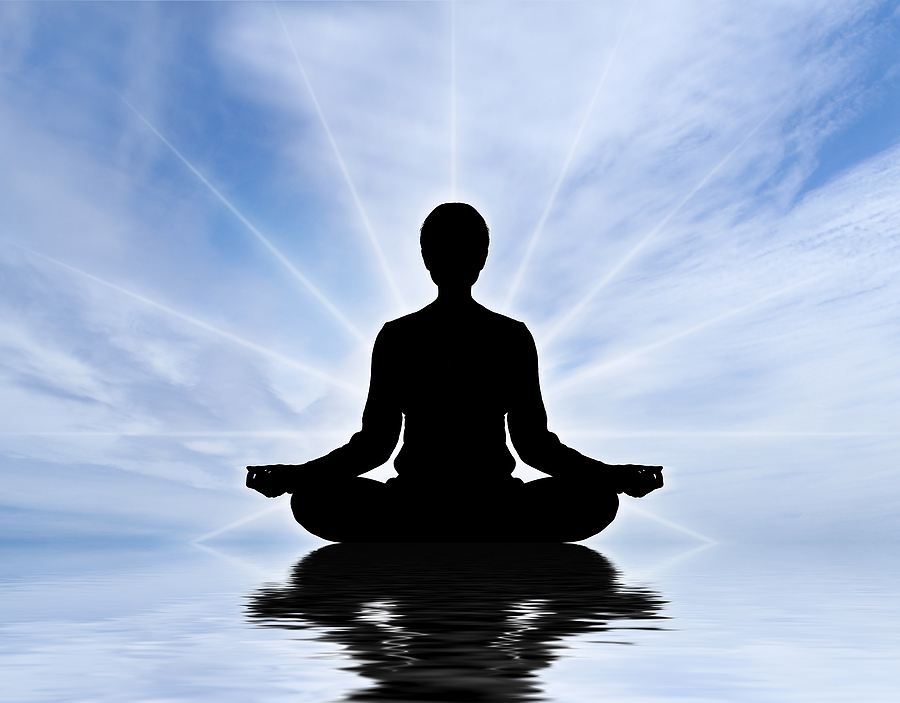
The goals of meditation intersect with many of the goals of clinical psychology, preventive medicine, and education. A growing body of research suggests that meditation can be effective in treating depression, chronic pain, and promoting a general sense of well-being.
The discovery of the benefits of meditation is consistent with recent findings by neuroscientists that the adult brain retains the ability to change significantly under the influence of experience. It has been shown that changes occur in the brain when, for example, we learn to juggle or play a musical instrument, a phenomenon called neuroplasticity. As the skill of the violinist increases, the areas of the brain that control the movements of the fingers increase. Apparently, similar processes occur during meditation. Nothing changes in the environment, but the meditator regulates his mental state, creating an internal experience that affects the functioning and structure of the brain. As a result of ongoing research, evidence is accumulating of the positive effects of meditation on the brain, thinking, and even on the whole body as a whole.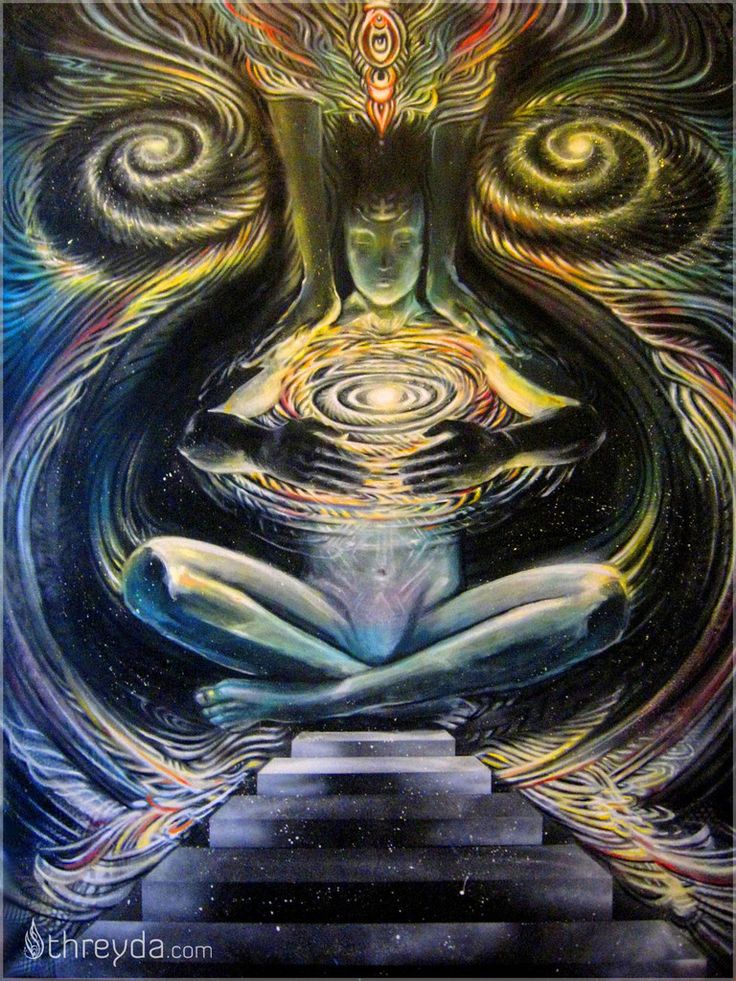
WHAT IS MEDITATION?
Meditation is found in the spiritual practices of almost all major religions, media. Mentioning meditation, use this word in different meanings. We will talk about meditation as a way to develop basic human qualities, such as stability and clarity of mind, peace of mind, and even love and compassion, qualities that dormant until a person makes an effort to develop them. Meditation is also a process of getting to know a more relaxed and flexible lifestyle.
Meditation is fairly simple and can be practiced anywhere. This does not require special equipment or clothing. To begin the “training”, a person must take a comfortable posture, not too tense, but not too relaxed, and wish for changes in oneself, well-being for oneself and relief of suffering for other people. Then it is necessary to stabilize the consciousness, which is often disordered and filled with a stream of internal noise. To control consciousness, it must be rid of automatic mental associations and internal absent-mindedness.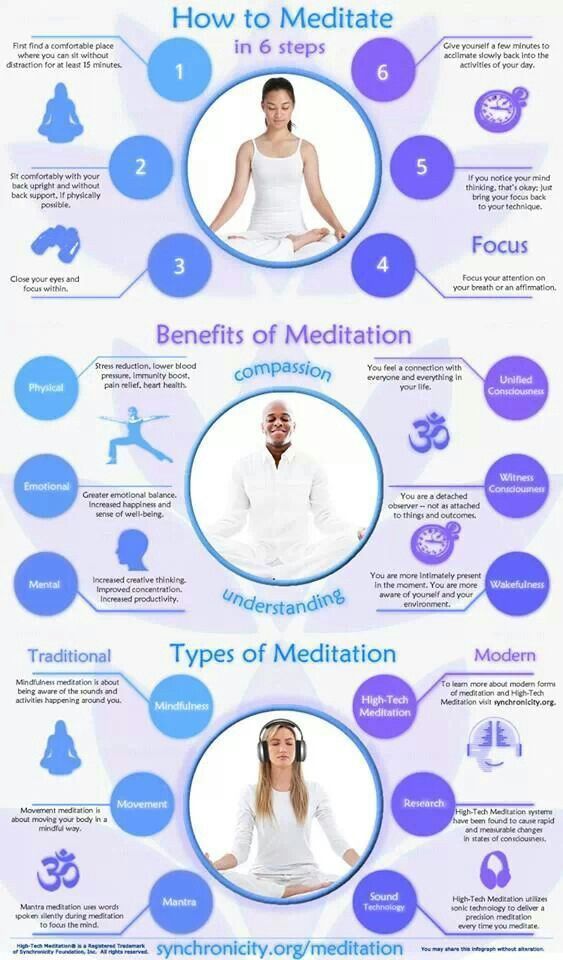
TYPES OF MEDITATION
Attention concentration meditation. This type of meditation usually requires you to focus on the rhythm of your own inhalation and exhalation. Even for experienced meditators, attention can slip away, and then it must be brought back. At Emory University, brain scans have identified different areas involved in the switching of attention during this type of meditation.
Mindfulness meditation. It is also called meditation of free perception. In the process of meditation, a person is exposed to various auditory, visual and other stimuli, including internal sensations and thoughts, but does not let them carry him away. Experienced meditators experience reduced activity in areas of the brain associated with anxiety, such as the insula and amygdala.
Meditation of compassion and loving-kindness. In this type of meditation one cultivates a feeling of benevolence towards another person, whether friend or foe. At the same time, the activity of areas associated with imagining oneself in the place of another person increases, for example, activity in the temporoparietal node increases.
At the same time, the activity of areas associated with imagining oneself in the place of another person increases, for example, activity in the temporoparietal node increases.
Advances in neuroimaging and other technologies have allowed scientists to understand what happens in the brain during each of the three main forms of Buddhist meditation: concentration, awareness, and compassion. The diagram below allows you to see the cycle of events that occur during attentional meditation and the activation of their corresponding brain areas.
Consider what happens in the brain during three common types of meditation that originated in Buddhism and are now used outside of a religious context in hospitals and schools around the world. The first type of meditation is the so-called concentration meditation. : consciousness at the current moment of time is limited and directed, developing the ability not to be distracted. The second type - mindfulness meditation (clear mind) or free perception, during which a person seeks to develop a calm understanding of his own emotions, thoughts and feelings that he is currently experiencing, so as not to allow them to get out of control and bring him to a mental disorder. In this type of meditation, a person remains attentive to any of their experiences, but does not focus on anything specific. And finally, the third type is known in Buddhist practice as compassion and mercy and promotes an altruistic attitude towards others.
In this type of meditation, a person remains attentive to any of their experiences, but does not focus on anything specific. And finally, the third type is known in Buddhist practice as compassion and mercy and promotes an altruistic attitude towards others.
UNDER SUPERVISION OF INSTRUMENTS
Neuroscientists have only recently begun to study the phenomena that occur in the brain during various types of meditation. Emory University's Wendy Hasenkamp and colleagues used tomography to identify areas of the brain that show increased concentration activity during meditation. Being in the tomograph, the subjects focused on the sensations during breathing. Usually attention begins to slip, the meditator must recognize this and regain focus on the rhythm of inhalation and exhalation.
In this study, the subject had to use a button to signal a loss of attention.
Researchers determined that there is a cycle of four stages : escape of attention, moment of awareness of distraction, reorientation of attention and resumption of focused attention.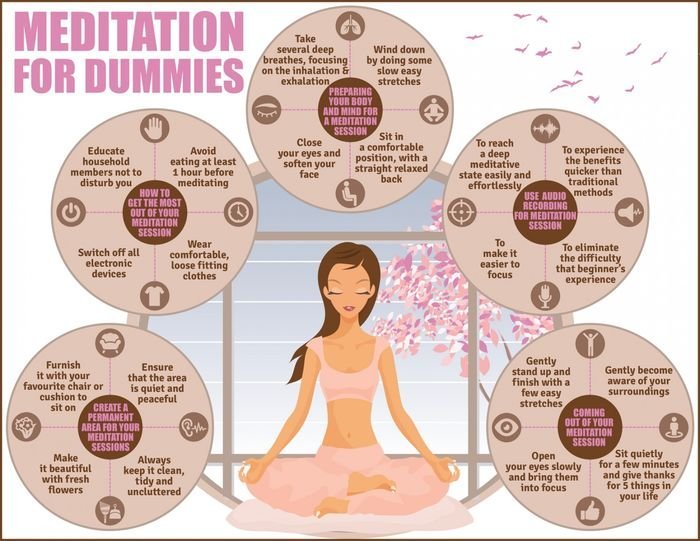 Each of the four stages involves a different part of the brain.
Each of the four stages involves a different part of the brain.
- First stage , when distraction occurs, the activity of the areas that form the network of the passive mode of the brain increases. It combines areas such as the medial prefrontal cortex, posterior cingulate cortex, precuneus, inferior parietal lobule, and lateral temporal cortex. It is known that these structures are active at a time when we are "head in the clouds." They play a leading role in creating and maintaining an internal model of the world based on long-term memory of themselves and others.
- Second stage , when a distraction is recognized, other areas of the brain are activated - the anterior part of the insula and the anterior cingulate cortex (the structures form a network responsible for cognitive and emotional functions). These areas are associated with subjectively perceived feelings, which can, for example, contribute to distraction during a task. They are supposed to play a key role in identifying new events and switching between different networks of neurons during meditation.
 For example, they can bring the brain out of a passive mode of operation.
For example, they can bring the brain out of a passive mode of operation.
- Third stage , additional areas are involved, including the dorsolateral prefrontal cortex and the inferolateral parietal lobe, which return attention by "unhooking" it from the distracting stimulus.
- And finally, at the last, fourth stage maintains a high level of activity in the dorsolateral prefrontal cortex, which allows you to keep the attention of the meditator on a given goal, such as breathing.
Later, in our laboratory in Wisconsin, we observed differences in brain activity depending on the experience of the subjects. Paradoxically, people who had a serious experience of meditation (more than 10 thousand hours), compared with beginners, there was less activity in areas associated with the restoration of attention. As people gain experience, they learn to hold their attention with less effort. A similar phenomenon is observed in professional musicians and athletes who perform actions automatically with minimal conscious control.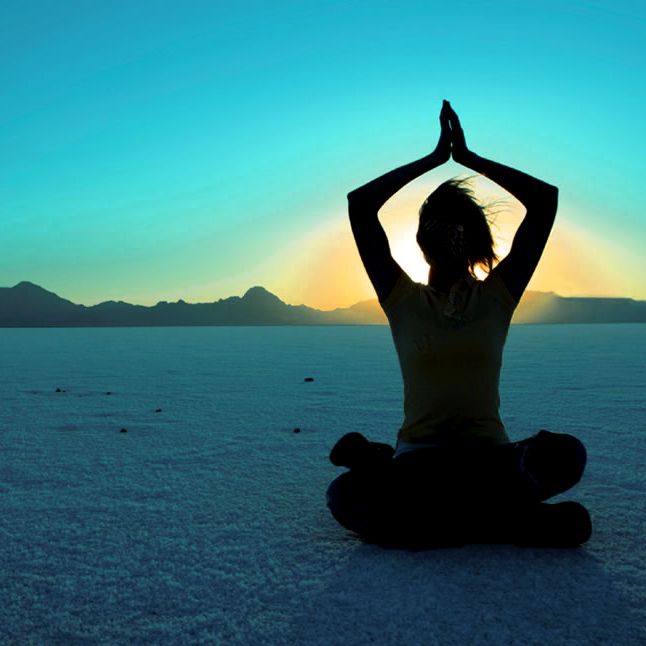
In addition, to investigate the effects of mindfulness-related meditation, we studied volunteers before and after a three-month period of intense training for at least eight hours a day. They were given headphones, from which sounds of a certain frequency were heard, and sometimes slightly higher sounds. For ten minutes, people had to focus on the sounds and respond to the higher tone that emerged. It turned out that people after a period of prolonged meditation had less differences in reaction speed from time to time compared to those who did not meditate. This means that after long-term training of consciousness, a person retains attention better and is less likely to be distracted. In people with meditation experience, electrical activity in response to high-pitched sounds was more stable.
STREAM OF CONSCIOUSNESS
Second , also a well-studied form of meditation another type of attention is involved. In mindfulness and free perception meditation, the meditator must notice all sights or sounds and keep track of his sensations, as well as internal dialogue. A person stays aware of what is happening, not focusing on any one feeling or one thought. And he returns himself to this detached perception, as soon as the consciousness begins to wander. As a result of such exercises, the usual everyday annoying events - an aggressive colleague at work, a pushy child at home - lose their destructive effect, and a sense of psychological well-being develops.
A person stays aware of what is happening, not focusing on any one feeling or one thought. And he returns himself to this detached perception, as soon as the consciousness begins to wander. As a result of such exercises, the usual everyday annoying events - an aggressive colleague at work, a pushy child at home - lose their destructive effect, and a sense of psychological well-being develops.
Being aware of unpleasant sensations reduces maladaptive emotional responses, helps to overcome unpleasant sensations, and may be especially helpful in managing pain. In our lab in Wisconsin, we have studied people who have a lot of meditation experience while they are doing a complex form of mindfulness meditation called open presence. In this kind of meditation, which is sometimes also called pure perception, the mind is calm and relaxed, not focused on anything, but at the same time a vivid clarity of mind is maintained without excitement or inhibition. The meditator observes without trying to interpret, change, get rid of, or ignore the painful sensations. We found that meditation does not reduce the intensity of pain, but it bothers the meditator less than people in the control group.
We found that meditation does not reduce the intensity of pain, but it bothers the meditator less than people in the control group.
Compared with beginners, people with extensive experience in meditation had less activity in areas of the brain associated with anxiety in the period before pain exposure. - Islet and amygdala. With repeated pain exposures, the brains of experienced meditators experienced faster habituation in areas associated with pain than novice meditators. In other tests done in our lab, mind training has been shown to increase the ability to control and mitigate basic physiological responses, such as inflammation or hormone release, in socially stressful situations such as public speaking or mental arithmetic in the face of a strict commission.
Several studies have shown that mindfulness meditation has beneficial effects on symptoms of anxiety or depression and improves sleep. By being able to consciously observe and monitor their thoughts and emotions, depressed patients can use meditation in anxious situations to manage spontaneous and intrusive negative thoughts and feelings.
Clinical psychologists John Teasdale of the University of Cambridge and Zindel Segal of the University of Toronto showed in 2000 that in patients who had previously experienced at least three periods of depression, after six months of mindfulness meditation when combined with cognitive psychotherapy, the risk of relapse within a year is reduced by about 40%. Later, Sehgal showed that meditation works better than placebo, and is comparable in effectiveness to standard antidepressant therapies.
COMPASSION AND MERCY.
Dalai Lama. Dialogue with Scientists on Compassion (Emory University). Part 1
Dalai Lama. Dialogue with Scientists on Compassion (Emory University). Part 2
Third type of meditation develops feelings of compassion and mercy towards people. First, the meditator is aware of the needs of the other person, then feels a sincere desire to help or alleviate the suffering of other people, protecting them from their own destructive behavior.
Having entered the state of compassion, the meditator sometimes begins to experience the same feelings as another person. But for the formation of a compassionate state, it is not enough to simply have an emotional resonance with the feelings of another. There must still be a disinterested desire to help to the one who suffers.
This form of love and empathy meditation is more than just a spiritual exercise. It has been shown to help maintain the health of social workers, teachers, and others who are at risk of burnout due to the experiences they experience by deeply empathizing with other people's problems.
Meditation begins with one focusing on unconditional benevolence and love for others and silently repeating a wish to oneself, for example: "May all living beings find their happiness and be free from suffering." In 2008, we studied the brain activity of people who practiced this type of meditation for thousands of hours. We let them listen to the voices of those suffering and found that they had increased activity in certain areas of the brain. Empathy and other emotional responses are known to be involved in the secondary somatosensory cortex and insula. When listening to suffering voices in experienced meditators, compared to the control group, these structures became more active. This means that they were better at sharing other people's feelings without feeling emotionally overwhelmed. Experienced meditators also showed increased activity in the temporoparietal ganglion, medial prefrontal cortex, and anterior temporal sulcus region. All these structures are usually activated when we mentally put ourselves in the place of another person.
Empathy and other emotional responses are known to be involved in the secondary somatosensory cortex and insula. When listening to suffering voices in experienced meditators, compared to the control group, these structures became more active. This means that they were better at sharing other people's feelings without feeling emotionally overwhelmed. Experienced meditators also showed increased activity in the temporoparietal ganglion, medial prefrontal cortex, and anterior temporal sulcus region. All these structures are usually activated when we mentally put ourselves in the place of another person.
Recently, Tania Singer and Olga Klimencki of the Institute of Human Cognitive Science and Brain Science of the Society. Max Planck, together with one of the authors of this article (Mathieu Ricard), tried to understand the differences between ordinary empathy and compassion in a meditator. They showed that empathy and altruistic love are associated with positive emotions and suggested that emotional exhaustion or burnout is, in fact, "fatigue" of empathy.
In accordance with the Buddhist traditions of contemplation, from which this practice came, compassion should not cause fatigue and despondency, it strengthens inner balance, strength of mind and gives determination to help those who suffer . When a child is admitted to the hospital, a mother will do more good by holding his hand and comforting him with gentle words than if, overwhelmed with empathy and anxiety, unable to bear the sight of a sick child, she rushes up and down the corridor. In the latter case, the case may end in burnout, from which, according to studies conducted in the United States, approximately 60% of the 600 interviewed carers suffered.
To further explore the mechanisms of empathy and compassion, Klimecki and Singer divided about 60 volunteers into two groups. In the first group, meditation was associated with love and compassion, in the other group they developed a sense of empathy for others. Preliminary results showed that a week of loving-kindness-compassion-based meditation led participants, although inexperienced, to experience more positive feelings while watching videos of suffering people. Participants from the other group, who only practiced empathy for a week, experienced the same emotions as the suffering people in the video. These emotions caused negative feelings and thoughts, and the participants in this group experienced a lot of stress.
Participants from the other group, who only practiced empathy for a week, experienced the same emotions as the suffering people in the video. These emotions caused negative feelings and thoughts, and the participants in this group experienced a lot of stress.
Having identified these devastating effects, Singer and Klimecki led the second group into compassion meditation. It turned out that the additional sessions reduced the negative effects of empathy training: the number of negative emotions decreased, while the number of benevolent emotions increased. This was accompanied by corresponding changes in brain regions associated with empathy, positive emotions, and maternal love, including the orbitofrontal cortex, ventral striatum, and anterior cingular cortex. In addition, the researchers showed that practicing compassion for a week increased prosocial behavior in a computer game specifically designed to assess willingness to help others.
Meditation not only causes changes in certain cognitive and emotional processes, but also contributes to the increase in certain areas of the brain.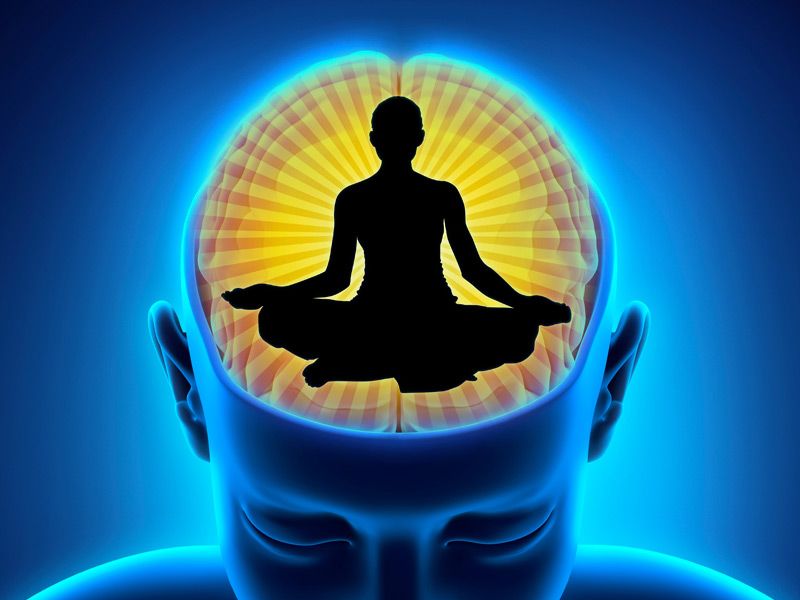 The study found that people with more meditative experience had increased gray matter volume in the insula and prefrontal cortex.
The study found that people with more meditative experience had increased gray matter volume in the insula and prefrontal cortex.
DOORS OF CONSCIOUSNESS
Meditation helps to study the nature of thinking, giving a person the opportunity to explore his own consciousness and mental state. In Wisconsin, we studied the electrical activity of the brain in Buddhists with extensive meditation experience by recording an electroencephalogram (EEG) during compassion meditation.
It turned out that experienced Buddhists could voluntarily maintain a state characterized by a certain rhythm of the electrical activity of the brain, namely, high-amplitude gamma oscillations with a frequency of 25-42 Hz. This coordination of brain electrical activity can go a long way in creating temporary neural networks that connect cognitive and emotional functions in learning and conscious awareness, which can lead to long-term changes in the brain.
During the meditation, high-amplitude oscillations continued for several tens of seconds, and the more they were, the greater was the experience of the meditator.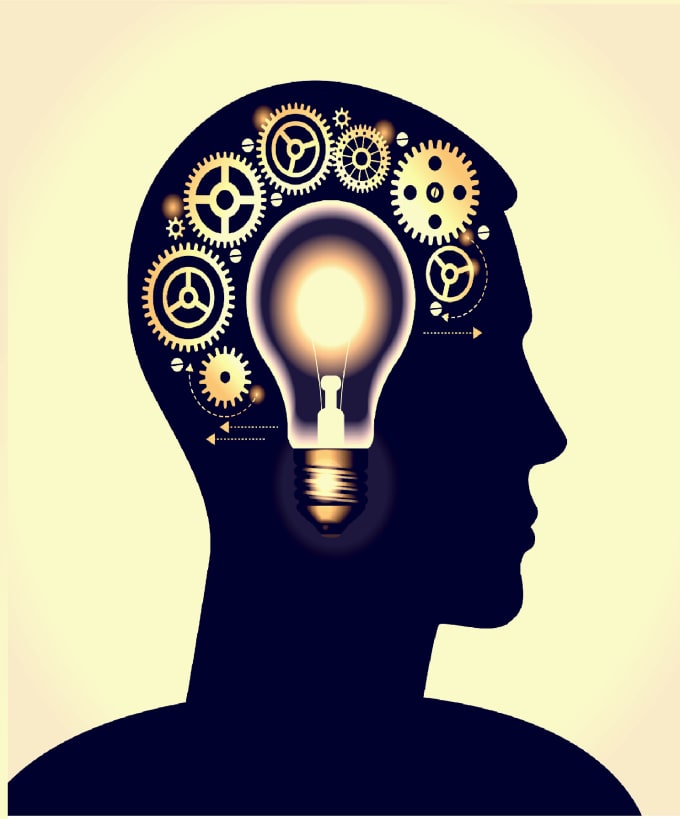 First of all, such features of the EEG were expressed in the lateral region of the fronto-parietal cortex. They may reflect people's increased awareness of the environment and internal thought processes, but more research is needed to understand the role of the gamma rhythm.
First of all, such features of the EEG were expressed in the lateral region of the fronto-parietal cortex. They may reflect people's increased awareness of the environment and internal thought processes, but more research is needed to understand the role of the gamma rhythm.
Brain Growing
Researchers at several universities have studied the ability of meditation to induce structural changes in brain tissue. Using MRI, it was possible to show that in 20 people with extensive experience in Buddhist meditation, the volume of tissue in some areas of the prefrontal cortex (Brodmann fields 9 and 10) and in the insula is larger compared to the brains of people from the control group (graphs). These areas are involved in the processing of information related to attention, internal sensations and sensory signals. Further long-term studies are required to confirm the data.
Meditation not only causes changes in certain cognitive and emotional processes, but also contributes to the increase in certain areas of the brain.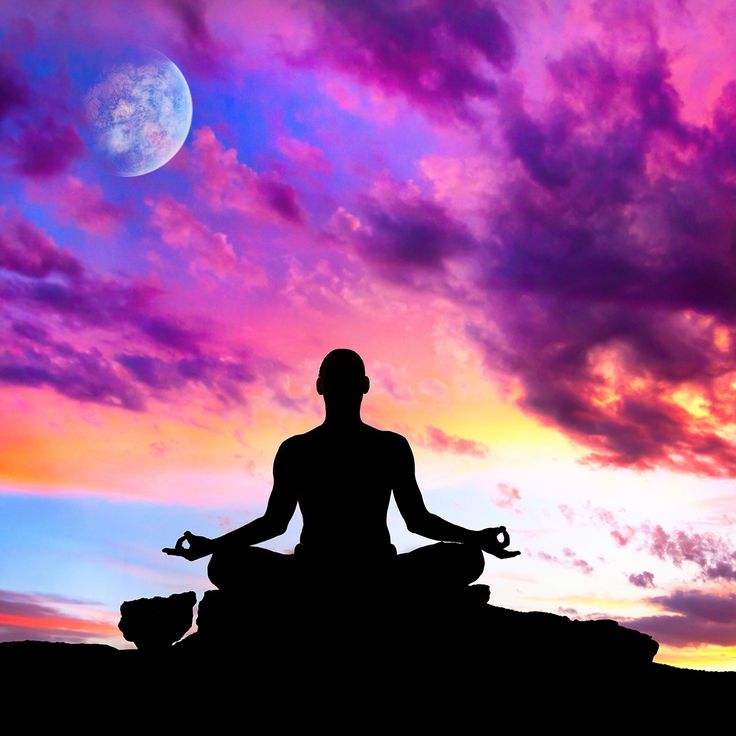 This is presumably caused by an increase in the number of connections between neurons. A preliminary study by Sara Lazar and colleagues at Harvard University found that people with extensive meditative experience had increased gray matter volume in the insula and prefrontal cortex, more specifically in fields 9and 10 according to Brodman, which are often activated in various forms of meditation. These differences were most pronounced in older study participants. It is hypothesized that meditation can slow down the rate of thinning of brain tissue that occurs with age.
This is presumably caused by an increase in the number of connections between neurons. A preliminary study by Sara Lazar and colleagues at Harvard University found that people with extensive meditative experience had increased gray matter volume in the insula and prefrontal cortex, more specifically in fields 9and 10 according to Brodman, which are often activated in various forms of meditation. These differences were most pronounced in older study participants. It is hypothesized that meditation can slow down the rate of thinning of brain tissue that occurs with age.
In further work, Lazar and colleagues showed that those subjects who, as a result of practicing mindfulness meditation, the most reduced stress response, also decreased the volume of the amygdala, a brain area involved in the formation of fear. Later, Eileen Luders of the University of California, Los Angeles, and colleagues discovered that meditators differ in the number of axons, the fibers that connect different parts of the brain. This is thought to be due to an increase in the number of connections in the brain. This observation lends support to the notion that meditation does induce structural changes in the brain. An important drawback of these works is the lack of long-term studies in which people would be observed over many years, and the absence of comparative studies of people of the same age and similar background, which would differ only in whether they meditate or not.
This is thought to be due to an increase in the number of connections in the brain. This observation lends support to the notion that meditation does induce structural changes in the brain. An important drawback of these works is the lack of long-term studies in which people would be observed over many years, and the absence of comparative studies of people of the same age and similar background, which would differ only in whether they meditate or not.
There is even evidence that meditation and its ability to improve one's own well-being can reduce inflammation and other biological reactions that occur at the molecular level. As shown in a study conducted jointly by our group and a group led by Perla Kaliman of the Institute for Biomedical Research in Barcelona, for an experienced meditator, one day of intensive mindfulness meditation is enough to reduce the activity of genes associated with the inflammatory response and affect proteins that activate these genes. Cliff Saron of the University of California at Davis has been studying the effects of meditation on a molecule involved in regulating cell lifespan. This molecule is the enzyme telomerase, which lengthens DNA at the ends of chromosomes. The ends of chromosomes, called telomeres, keep the genetic material intact during cell division. During each division, telomeres shorten, and when their length is reduced to a critical value, the cell stops dividing and gradually ages. Compared with the control group, meditators were more effective in reducing psychological stress and had higher telomerase activity. Sometimes practicing mindfulness meditation can slow down the cellular aging process.
This molecule is the enzyme telomerase, which lengthens DNA at the ends of chromosomes. The ends of chromosomes, called telomeres, keep the genetic material intact during cell division. During each division, telomeres shorten, and when their length is reduced to a critical value, the cell stops dividing and gradually ages. Compared with the control group, meditators were more effective in reducing psychological stress and had higher telomerase activity. Sometimes practicing mindfulness meditation can slow down the cellular aging process.
THE WAY TO WELFARE
Over 15 years of research, it has been possible to show that prolonged meditation not only significantly changes the structure and function of the brain, but also significantly affects the biological processes that are critical for physical health.
Further research is needed, using well-defined randomized controlled trials, to separate the effects caused by meditation from those associated with other psychological factors that may also influence the results of the studies. These are, for example, the level of motivation of meditators and the roles played by teachers and students in a group of meditators. Further research is also needed to find out the possible negative side effects of meditation, the desired duration of the sessions, and how to adapt them to the needs of a particular person.
These are, for example, the level of motivation of meditators and the roles played by teachers and students in a group of meditators. Further research is also needed to find out the possible negative side effects of meditation, the desired duration of the sessions, and how to adapt them to the needs of a particular person.
But even with all the precautions, it is clear that as a result of research on meditation, we have received a new understanding of methods of psychological preparation that can potentially improve human health and well-being. Equally important, the ability to develop compassion and other positive human qualities lays the foundation for the creation of ethical norms that are not tied to any philosophy or religion. This can profoundly and beneficially affect all aspects of human society.
Richard Davidson (Richard J. Davidson) is director of the Weissman Neuroimaging and Behavior Laboratory and Center for Mental Health Research at the University of Wisconsin-Madison. He was the first to begin the scientific study of meditation.
He was the first to begin the scientific study of meditation.
Antoine Lutz (Antoine Lutz) is a Research Fellow at the French National Institute of Health and Medical Research at the University of Wisconsin at Madison. Led the neuroscience research on meditation.
Mathieu Ricard (Matthieu Ricard) - Buddhist monk. He studied cell biology, and then, about 40 years ago, he left France and went to the Himalayas to study Buddhism.
We know perfectly well what life is like on a knurled track, on "autopilot". The usual morning routine, shower, coffee on the go, kissing neighbors, driving to work, checking mail, likes on social networks, work ... Almost always, with rare exceptions, the “autopilot” is on. Most of the time, we are controlled by others.
This state is also called the "trance of everyday life", a state in which our attention narrows down to primitive "yes-no", "can-not" and "good-bad". Few of us consciously give our lives in control of others, rather, it turns out that way.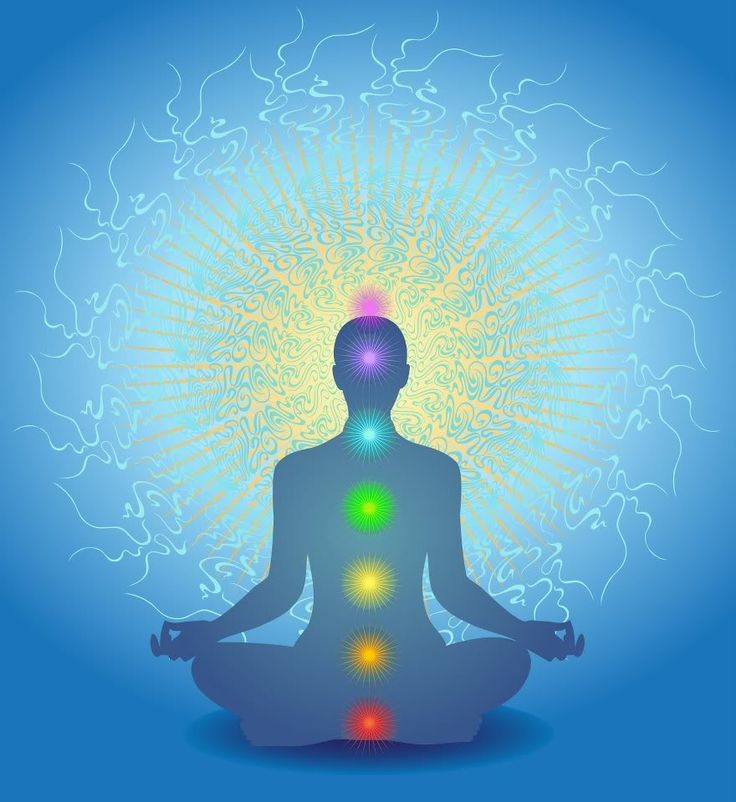 Somehow by itself, and it seems that we did nothing for this.
Somehow by itself, and it seems that we did nothing for this.
That's right: we didn't do anything, we just lived unconsciously. Mindfulness is a state of consciousness, the opposite of "autopilot"
When we direct attention to ourselves, we become aware of ourselves and can manage ourselves, our lives. Sounds tempting. Shall we try?
RESULT: REAL PRESENCE
We often face complex tasks that cannot always be solved on "autopilot". Negotiations and presentations, projects and innovations that can change our own lives and the lives of loved ones. Talking to a child is also a difficult task.
What is needed for full awareness:
- see - first of all, people and their condition;
- hear - everything that is said and how it is said;
- feel - attitude and emotions, one's own and others;
- feel - our strength and confidence in what we do;
- be aware - your thoughts and choose the most correct ones;
- know - the situation in general and the state of affairs in particular.

We are able to control our perception, thinking and actions
The goal and result of awareness is true presence, a state of concentration and complete inclusion, which in itself commands respect and attention. Then we need to act, and act actively. Mindfulness meditation makes it possible to get out of the trance of everyday life, turn off the “autopilot” and be an included participant or leader in the process.
KEY IDEAS IN MINDNESS PRACTICES
A few important ideas that describe the essence of mindfulness practices:
- a person in his usual state is not a very conscious being, more often we live on "autopilot";
- we are able to control our perception, thinking and actions;
- non-judgmental observation of what is happening in the mind and in the outside world allows you to objectively and adequately perceive what is happening;
- awareness allows you to more meaningfully respond to the challenges of life, makes life rich and successful;
- Mindfulness develops through gradual, daily, regular practice.

Mindfulness is developed by gradual, daily, regular practice
Basic Mindfulness Tools:
- breathing meditation;
ATTITUDE TO SELF IN AWARENESS MEDITATION
In order to actually practice mindfulness, there are several important conditions. Mindfulness involves getting real, truthful information about ourselves and the world. Therefore, how we relate to ourselves and to the experience gained in meditation is extremely important. Here are the key principles of mindfulness:
Non-judgmental . Observe what you are experiencing as it is, without classification as "good" or "bad", "pleasant" or "unpleasant".
Non-striving . Allow yourself to experience whatever happens instead of setting goals and trying to achieve them.
Acceptance. Acceptance does not mean humility and submission; it is acceptance, not denial, of how you feel right now. Acceptance first, change will come later.
Patience. It takes time for changes to show up. It is necessary, over and over again, to try to do what is supposed to be as perfect as possible, not paying attention to the frustration and annoyance that not everything turns out perfectly.
Change takes time and practice to manifest
Trust . Trust yourself as you practice, let your "inner self" guide you.
Beginner's mind. Develop a "beginner's mind" as opposed to the usual "expert" filters. In the open "mind of a beginner", in contrast to the "mind of an expert" is a huge number of possibilities.
Release. Let go, you don't have to hold on to anything. There is no need to cling to pleasant experiences and push away unpleasant ones.
Interest . Be inquisitive about your experience: How do I feel now? What are the thoughts in my head right now? What is going on in my body?
Kindness. Bring warmth and compassion into your every second experience.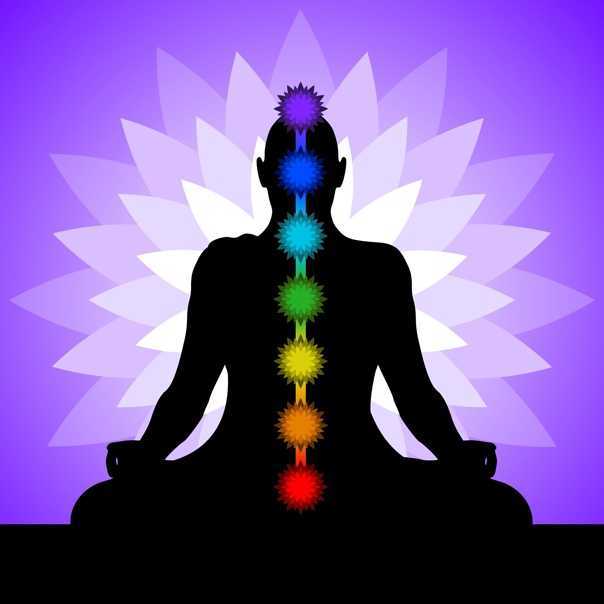 Be aware of your experience - not only with your mind, but also with your heart.
Be aware of your experience - not only with your mind, but also with your heart.
Bring warmth and compassion into your every second experience
Some points may seem strange (as it is non-judgmental, we always evaluate), but these are really important things in the process of meditation. These conditions are the essence of mindfulness practices. Apply or not - you decide for yourself, but first try. The criterion here is the result, and everything else is a waste of time and words. Try doing it this way!
SOME FACTS ABOUT MEDITATION
1. Mindfulness meditation develops the ability to control attention, thinking and emotions.
2. Mindfulness meditation is clarity and full contact with reality, it is inclusion and authentic presence.
3. In meditation, you can sit and just on a pillow or on a chair, the recommended duration of meditation is from 2-3 to 20-30 minutes.
4. Mindfulness meditation has its roots in Buddhist contemplative practice (there it is called shamatha-vipassana), its essence is attention and self-awareness.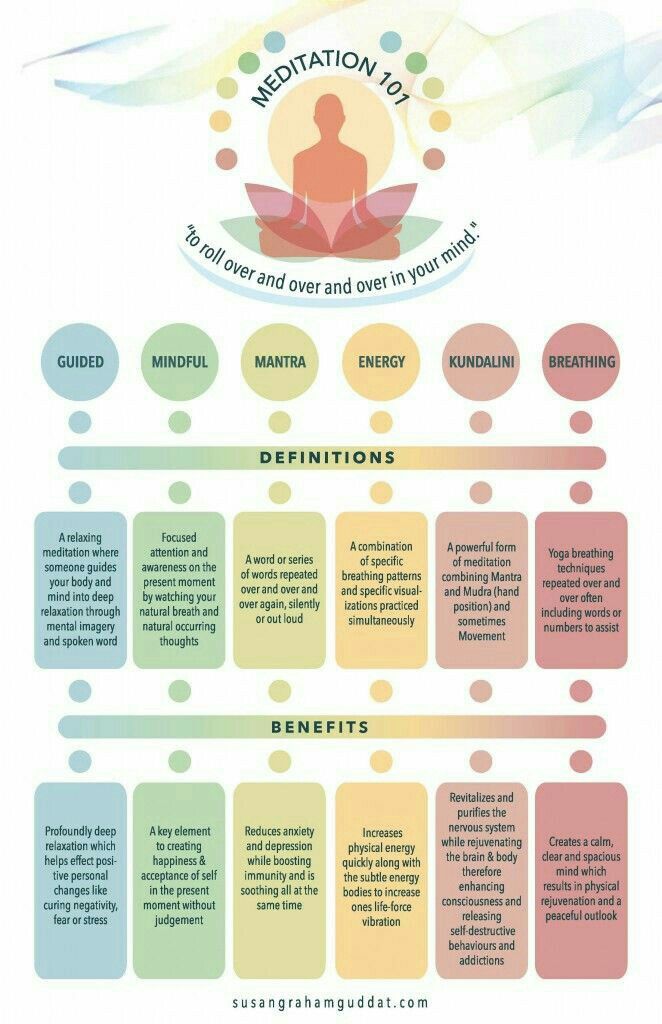
5. Mindfulness meditation is a scientifically based technique that has been successfully used in medicine, business, education and social work for more than 30 years.
THREE LEVELS OF THE PRACTICE OF MINDFUL MEDITATION
The skill of meditation develops gradually, over several months, subject to regular practice.
1 LEVEL . United meditation "concentration of attention" and "mindfulness (clear mind)". We learn to contact with ourselves, develop clarity and sensitivity, train attention, achieve calmness and confidence.
2 LEVEL (after 1-2 months of practice). We explore our defense mechanisms. We understand how we close ourselves off from the world, how fears and behavioral strategies arise, and gradually we begin to manage them.
3 LEVEL (after 3-4 months of practice). We develop a connection with the world and relationships with people. We learn empathy, understanding other people, open and clear communication with others.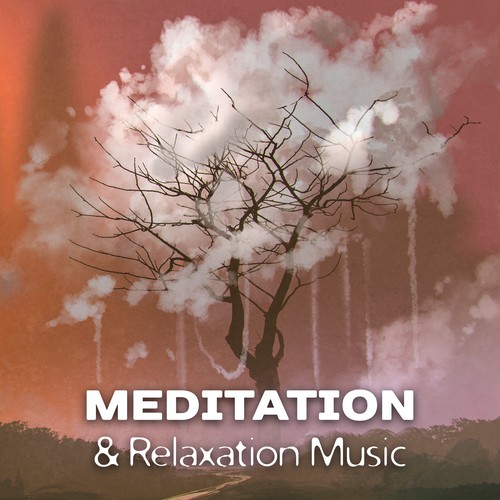
SELECTING A PLACE FOR PRACTICE
You can practice mindfulness wherever you can breathe. Only at the very beginning, in order to master mindfulness meditation, you need a quiet space. Therefore, it is better to start mindfulness meditation in specially equipped classes with an instructor, or at home, sitting on a pillow or on a chair in silence. Literally after a few weeks of classes, stability will appear and you can continue the practice anywhere.
You can practice mindfulness wherever you can breathe
Good options for meditation are halls, passages, recreation areas and parks. If you have no choice - start right where you are!
Part 3. MEDITATION ON THE MIND. How to Meditate
Part 3. MEDITATION ON THE MIND
Breathing meditation.
The main activity of the mind used in breathing meditations is awareness, that is, the ability of the mind to focus on some object without forgetting about it and not rushing to other objects every now and then.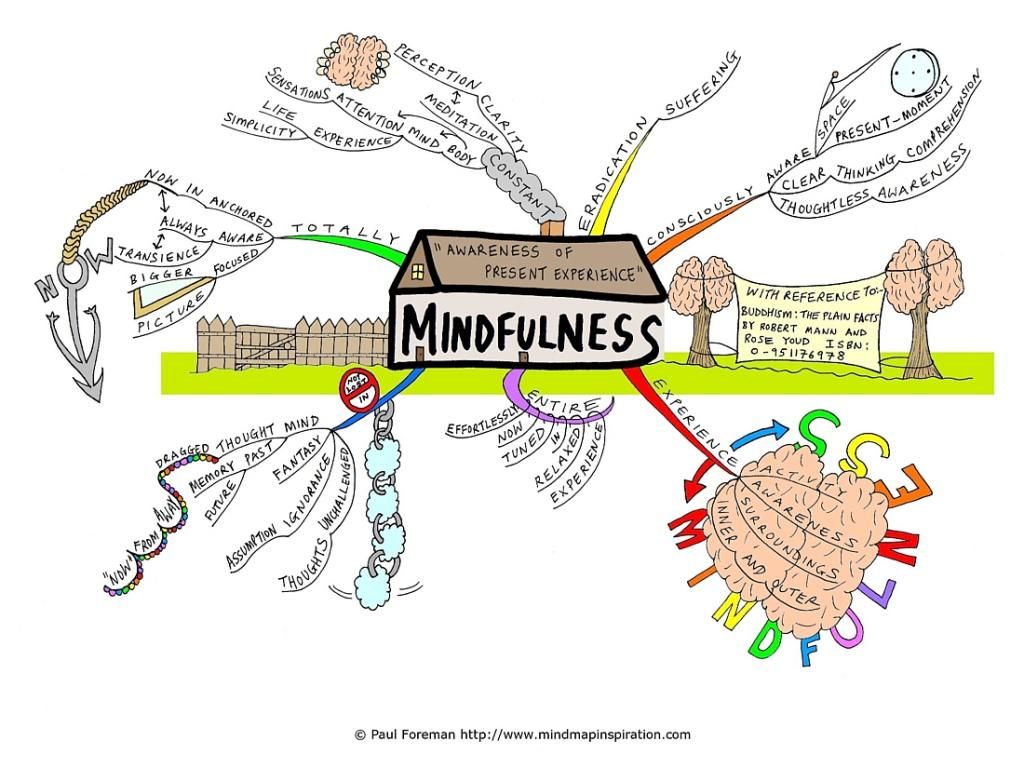 In the present case, our breath becomes the object of concentration. In its most effective form, mindfulness is accompanied by insightful vigilance, another function of the mind that guards us like a sentinel from confusing and distracting thoughts.
In the present case, our breath becomes the object of concentration. In its most effective form, mindfulness is accompanied by insightful vigilance, another function of the mind that guards us like a sentinel from confusing and distracting thoughts.
Mindfulness is essential for successful meditation. Day in and day out throughout life, mindfulness keeps us poised, alert, and aware, helping us to recognize what is going on in our mind just at the moment an event occurs, and thus competently deal with difficulties as they arise.
There are different methods of cultivating mindfulness, and each tradition has its own practices. I give descriptions of two options here. Choose the option with which you do not experience any discomfort, and constantly practice it. And it's best not to jump from one option to another.
You can use breathing meditation (in other words, mindfulness) as a main practice or a preparatory stage for other meditations. This is an invaluable technique. Its regular practice will help you gradually gain control over your mind. You will relax more fully, you will enjoy life more, you will feel more acutely both yourself and other people and things around you. By applying your increased awareness to other meditations, you will be able to concentrate for longer periods of time.
Its regular practice will help you gradually gain control over your mind. You will relax more fully, you will enjoy life more, you will feel more acutely both yourself and other people and things around you. By applying your increased awareness to other meditations, you will be able to concentrate for longer periods of time.
Therefore, mindfulness meditation is important for both beginners and long-term meditators. It is of great importance both for those who need simple techniques to relax and calm the mind, and for those who dedicate their lives to spiritual development.
Practice.
Sit with a straight back and relax your body. Imagine your motive or purpose for doing this meditation and firmly tell yourself that throughout the session you will keep your attention on the object of concentration in order to fulfill your goal.
For your practice, choose one of the following breath awareness methods:
1. Focus on the sensations at the tip of the nose, namely the nostrils, as you inhale and exhale.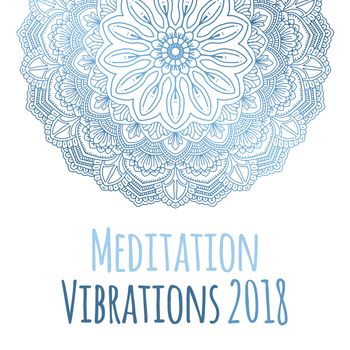 Keep your attention on this subtle perception and watch your every inhalation and exhalation throughout.
Keep your attention on this subtle perception and watch your every inhalation and exhalation throughout.
If you like, you can count cycles of five or ten breaths, starting again from the first breath whenever you lose count or your mind wanders.
2. Use the above method, but in this case focus on moving the abdomen up and down with each inhalation and exhalation.
Whichever method you choose, breathe normally and softly. Thoughts will inevitably arise in you, but you treat them neutrally, without attracting or repelling them. In other words, do not react with rejection, anxiety, excitement, or attachment to any thought, image, or feeling that arises in you. Just notice their existence and return your attention to the object of meditation. Even if you have to do it fifty times a minute, don't lose heart! Be patient and persistent. Eventually your thoughts will disappear.
Imagine that your mind is like a calm, clear lake or a vast empty sky: flashes appear on the surface of the lake, clouds float across the sky, but soon they disappear without disturbing the natural serenity of nature.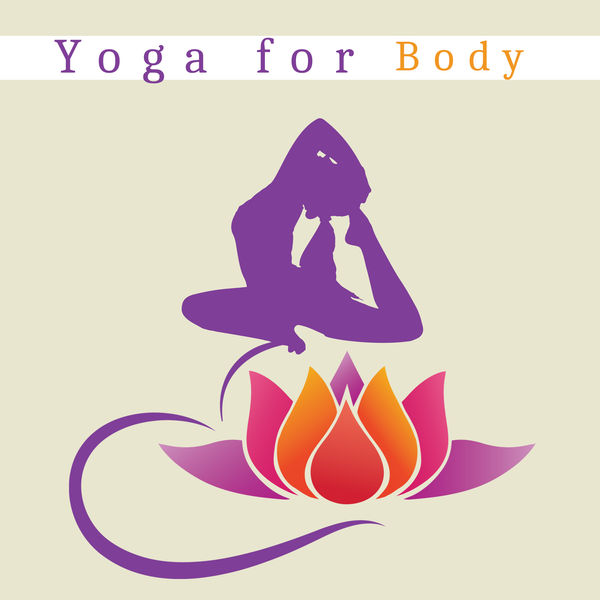 Thoughts come and go. They are fleeting, fleeting. Notice them and let go, constantly returning attention to the breath.
Thoughts come and go. They are fleeting, fleeting. Notice them and let go, constantly returning attention to the breath.
Enjoy the present moment. Accept any state of your mind and whatever arises in it. Let go of expectations, attachment and frustration. Don't want to be somewhere else, do something else, or even feel different. You are good and the way you are now.
When your skill has increased, when your ability to avoid embarrassment has increased, take one more step in developing your vigilance. Notice in your mind the nature of the thoughts that arise, such as "I am thinking of a friend," "I am thinking of breakfast," "I hear a bird," "I am angry," "I am bored." So you can define "fantasy," "attachment," "memory," "sound," "pain." Once you have noted the thought or feeling, release it by remembering the nature of its impermanence.
Another technique is to use your absent-mindedness to help you gain insight into the nature of the mind. When a thought arises, instead of focusing on the thought itself, focus on the thinker. This means that a part of the mind, namely penetrating vigilance, is looking at another part, namely absent-mindedness. The confusing object will disappear, but keep your attention on the thinker for as long as possible. When the next thought arises, focus on the thinker and follow the previous procedure. Return to contemplation of the breath as soon as distraction is eliminated.
This means that a part of the mind, namely penetrating vigilance, is looking at another part, namely absent-mindedness. The confusing object will disappear, but keep your attention on the thinker for as long as possible. When the next thought arises, focus on the thinker and follow the previous procedure. Return to contemplation of the breath as soon as distraction is eliminated.
These methods of eliminating distraction can be applied to any meditation. There is no point in ignoring or suppressing embarrassing thoughts or negative energy, because the thoughts will only come at you with more force.
At the end of the session, dedicate the positive energy created by your meditation to the realization of the purpose with which you started the meditation.
Meditation on clarity of mind.
The reality of our existence is that we combine body and mind. Each of these phenomena is a combination of many parts, and all these parts are constantly moving. Unfortunately, our ego is not satisfied with such a simple explanation.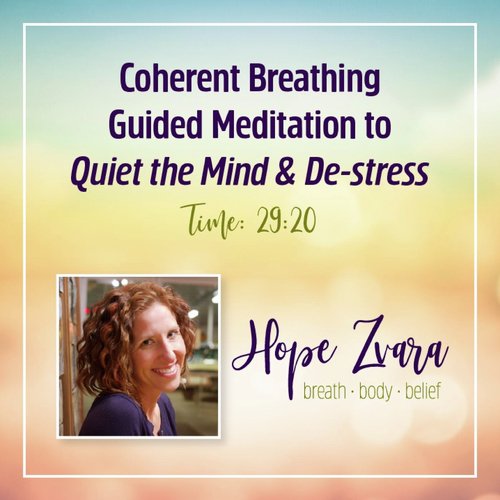 It complicates matters by artificially evoking a certain opinion of "I" or self. This opinion is based on our ideas, likes and dislikes. We think: "I'm attractive", "I'm ugly", "I'm a good dancer", "I won't succeed", "I have a bad temper". We take these projections on faith and consider them permanent and unchanging.
It complicates matters by artificially evoking a certain opinion of "I" or self. This opinion is based on our ideas, likes and dislikes. We think: "I'm attractive", "I'm ugly", "I'm a good dancer", "I won't succeed", "I have a bad temper". We take these projections on faith and consider them permanent and unchanging.
We do the same with the people and things around us in the world. We believe, that "he is disgusting", that "she is nice". We build our own sharp and very strong picture of reality and hold it without any doubt in it.
Meditation on mental clarity is an effective antidote to our gross projections. We can gain direct experience of the clear, immaterial, transient nature of all thoughts, feelings, and opinions, and thus lessen our tendency to identify ourselves with all of these. As the object, i.e. the mind, softens, so does the objects it projects: they slowly lose their hardness. It is a projection of my thought, which is clear and fleeting. It arises in my mind like a wave and will soon pass. I do not perceive the subject in its true form. "
I do not perceive the subject in its true form. "
This meditation is especially suitable for softening our perception of ourselves. We usually have low self-esteem based on past mistakes, personal flaws, bad habits, and stuff like that. But anger, jealousy, selfishness, depression and other difficulties that haunt us are mental experiences and are therefore clear and fleeting. The existence of such states of mind depends on our belief in them! Realizing this moment in meditation on the nature of the mind, we learn to free ourselves from experiences and stop our identification with them.
Our innermost nature is clear and pure, staying in us all day and night. Negativity, which comes and goes like ocean waves, is temporary and can be eliminated. The constant practice of this meditation will eventually instill in us such a strong confidence in this pure nature that it will become our very reality, our actual experience. This is a natural step towards understanding the more subtle nature of all phenomena and one's own nature, that is, the realization of the primordial emptiness of their existence.
Practice.
Begin by breathing deeply through both nostrils. Send air into the abdomen, hold it there for a few seconds, and then exhale slowly and gently through parted lips. Repeat this exercise twice, and then begin to breathe normally. Observe your breath without thinking or drawing any conclusions. Once your awareness has sharpened, focus your attention on the clarity of your consciousness.
Your consciousness, in other words your mind, is what you are experiencing at the present moment. I mean sensations in your body, thoughts, feelings, perception of sounds and so on. The nature of each of these experiences is clarity without form or color, sky-like pure awareness. Focus on this clear, pure nature of the mind.
At first, you may have difficulty finding the real object, that is, clarity. In this case, meditate on the mental image of clarity. One way to evoke such an image is to imagine space. Imagine that you are lying on a hill and looking up at a clear sky, completely free of clouds.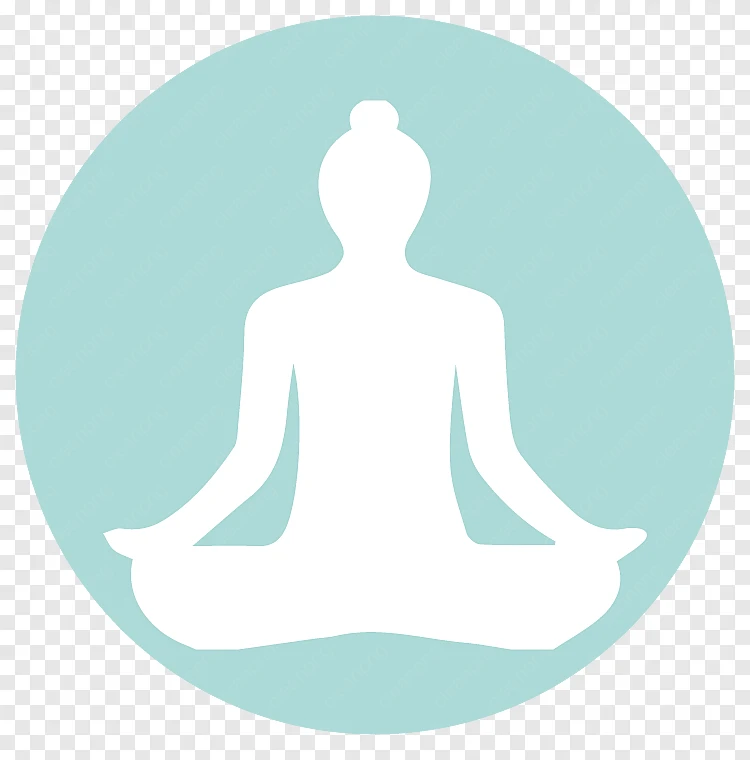 Concentrate on that vast, boundless emptiness. Imagine that she comes down and hugs you and everything around you. Everything is like empty space. Hold this experience. Feel that the nature of your mind is like pure empty space.
Concentrate on that vast, boundless emptiness. Imagine that she comes down and hugs you and everything around you. Everything is like empty space. Hold this experience. Feel that the nature of your mind is like pure empty space.
Distraction will arise in you, thoughts will appear, but do not react to them. Don't follow the thoughts and don't reject them. Remember that thoughts are pure by their very nature and immaterial. Just watch them come and go and then come back to the awareness of purity of mind.
Don't think of anything while meditating. You don't have to guess what the mind is. Simply observe the mind, its pure nature, which is like an endless empty space. Enough of this. Be natural. Meditation is simple and natural, there is no difficulty in it.
The point of concentration is to keep the mind constantly on the object without forgetting. Out of concentration, awareness free of concepts will spontaneously arise. The light does not need to think, "I am dispelling the darkness. " The light just shines. Mindfulness is the inner light that allows us to see things more clearly. It dispels the heaviness of the image in which things appear before us, and therefore weakens our clinging to or aversion to them.
" The light just shines. Mindfulness is the inner light that allows us to see things more clearly. It dispels the heaviness of the image in which things appear before us, and therefore weakens our clinging to or aversion to them.
Keep your meditation short, from ten minutes to half an hour. And so on until your concentration is perfect. Then you can sit for an hour or more while maintaining clear awareness. If the meditation is successful, then you will feel light and relaxed.
End the meditation by dedicating the positive energy generated during the session to the happiness and well-being of all beings.
Meditation on the continuity of the mind.
The mind is compared to a vast ocean, and our opinions, thoughts and emotions are like waves that rise and fall on its surface. This analogy helps us understand the experiences that arise when we sit in meditation or go about our daily activities. But in order to feel where and where the mind is moving, it is useful to imagine it as a river flowing through time.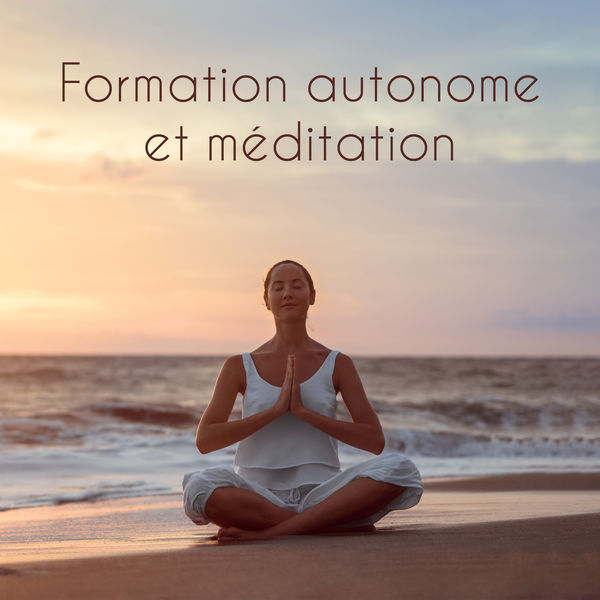
Every moment of the mind leads continuously to the next moment. The mind flows constantly, day and night, like a stream of countless fleeting experiences that are always changing. Thoughts and feelings arise and quickly disappear, but they leave traces that the mindstream carries with it.
Buddhism explains that the mind has neither beginning nor end, unlike the body, which is conceived, born, dies and decays. Our personality and experiences of this life take on the outlines of traces that the mind takes out from past lives. Likewise, everything we do and think now determines our future experiences. The decision is ours: we can be anything, we just need to direct our energy in some direction. In order to do this, we need to understand the mind and learn how to master it.
You accept that you can have other lives only when you master the mind. If you learn to remember the experiences of past lives, you will understand that this life is the past life of the future, and in the same way it will someday become a past life. When your mind is completely at peace, you will be able to go deep into past experiences. And you will be convinced of the existence of other lives only when you experience the reality of your past lives through your own experience.
When your mind is completely at peace, you will be able to go deep into past experiences. And you will be convinced of the existence of other lives only when you experience the reality of your past lives through your own experience.
However, this is an alien idea to most people. I will give several analytical approaches in order to convince you of the validity of my thesis about the continuity of the mind.
First of all, the mind is fickle and changeable, it changes from moment to moment. Thus, it is an effect, a result, a derivative of some cause. How can the mind originate in time if it is a series of instants continually succeeding each other, each of which is always the result of the previous instant?
Some people think that mind and brain are one and the same. But as already noted, the mind is the experience itself. And how can a thought or feeling be physical? The mind depends on the brain, on the nervous system, but it cannot be the brain itself.
The mind also cannot be a continuation of the minds of other people, for example, inherited from parents. If all that we now are and experience is nothing but the result of the past actions of our body, speech, and mind, then the mind must necessarily exist as a whole individuality.
If all that we now are and experience is nothing but the result of the past actions of our body, speech, and mind, then the mind must necessarily exist as a whole individuality.
The following meditation is very helpful for experiencing your own mind as a constantly flowing and ever-changing stream of events.
Practice.
Sit comfortably and relax. Think of a positive, beneficial motivation for doing meditation. Spend some time focusing on your breathing until your mind is calm and clear.
First, pay attention to the current state of your mind, to the thoughts and sensations flashing in it. Just be a detached contemplative of them, without clinging or rejecting anything.
And now start your journey back in time. Skim through your mind the conscious impressions you had after waking up this morning… Do these impressions originate in the same stream of consciousness as your current impressions?
You must have been dreaming before waking up. Try to remember last night's dreams... Do they also belong to the same mental continuum? Keep reviving the experiences of the mind; what did you do yesterday, the day before yesterday, two weeks ago, a month, a year, two years, five years, ten? Constantly check whether these experiences belong to the same stream of consciousness.
Try to remember last night's dreams... Do they also belong to the same mental continuum? Keep reviving the experiences of the mind; what did you do yesterday, the day before yesterday, two weeks ago, a month, a year, two years, five years, ten? Constantly check whether these experiences belong to the same stream of consciousness.
Don't let the memories get carried away. The purpose of meditation is not to relive good times or dig up problems from the past, but to feel the continuity of the mind. If you need to find something in your memory that you want to sprout in the future, put it off for another day.
Go back as far as possible to the beginning of life, recall the experiences of youth and childhood... Sometimes people manage to remember their early childhood, even infancy. Relax and open your mind for such memories to burst into it ... Perhaps you will be able to remember something from another life.
So you've traveled to the earliest point in your life that you can remember, now gently shift your focus of awareness to the present and re-examine the thoughts and feelings that arise. Just feel the flow of your consciousness as it flows. Feel this chain: one thought or feeling leads to the next thought or feeling, and so on ad infinitum.
Just feel the flow of your consciousness as it flows. Feel this chain: one thought or feeling leads to the next thought or feeling, and so on ad infinitum.
Finally, try to understand where this stream originates. Contemplate the stream of your mind that will flow for the rest of the day, then tomorrow, in the following days, weeks and years ... and so on until death. And then what?
Consider different possibilities. Does the stream of consciousness suddenly cease to exist? Does it transform into something else? Does it continue to exist, acquiring new experiences?
Think carefully about these possibilities using the arguments above. And even if you do not come to any definite conclusion, the main thing for you is to look with a clear mind. Ultimately, dedicate any understanding you gain to the ultimate understanding of your mind for the benefit of all sentient beings.
Meditation Technology
Meditation Technology The best time to get in touch with the spiritual world is at the end of the day, when the whole world is on the verge of day and night. Your feelings at this time are sharpened, and the transition to another level of awareness of the World will be easier. During meditation, you should be
Your feelings at this time are sharpened, and the transition to another level of awareness of the World will be easier. During meditation, you should be
First part of meditation
First part of the meditation Sit opposite each other so that there is about 20 centimeters between your knees. Look into your partner's eyes, but in such a way that you feel this look from the very center of your being. Watch how the energy from
movesSecond part of meditation
Second part of the meditation When the first part of the meditation comes to an end, slowly look into the eyes of your partner with an absent-minded gaze. Try to create some space of detachment from a specific object, look inside your partner, contemplate him in
Part 2: ORGANIZING THE PRACTICE OF MEDITATION
Part 2.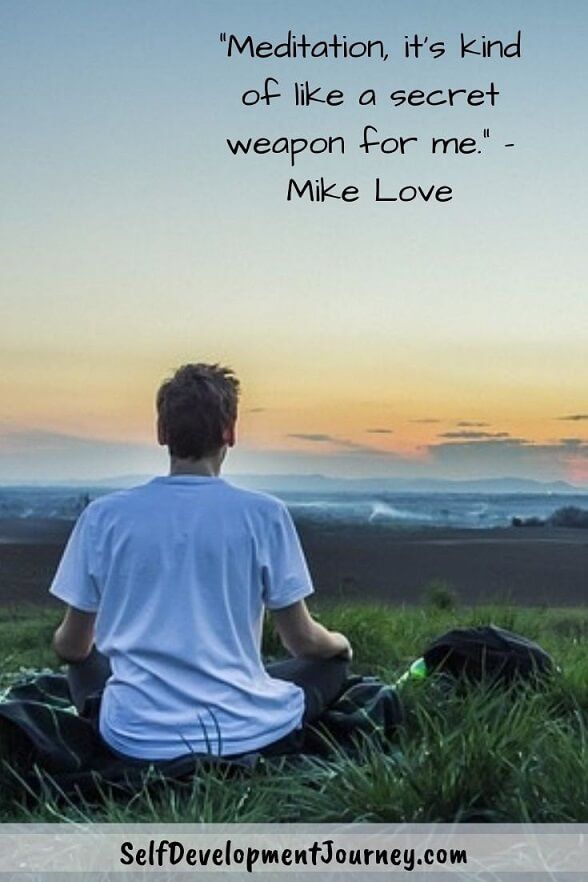 ORGANIZING THE PRACTICE OF MEDITATION Tips for beginners. Regular practice. In order to feel the benefits of meditation, you need to practice regularly. Here, as in any other kind of activity, it is impossible to succeed until we give meditation
ORGANIZING THE PRACTICE OF MEDITATION Tips for beginners. Regular practice. In order to feel the benefits of meditation, you need to practice regularly. Here, as in any other kind of activity, it is impossible to succeed until we give meditation
Part 4. ANALYTICAL MEDITATIONS
Part 4. ANALYTICAL MEDITATIONS General information about analytical meditations. The meditations presented in this book are solutions to a wide range of issues. These meditations will help you learn to perceive both the inner and outer world
Part 5. VISUALIZATION MEDITATIONS
Part 5. Visualization Meditations About visualization. Trying to calm and concentrate your mind, you may notice visual images among the many objects that distract attention from the subject of meditation: the faces of loved ones, your home, other memorable places, delicious food,
PART ONE ABOUT MEDITATION.
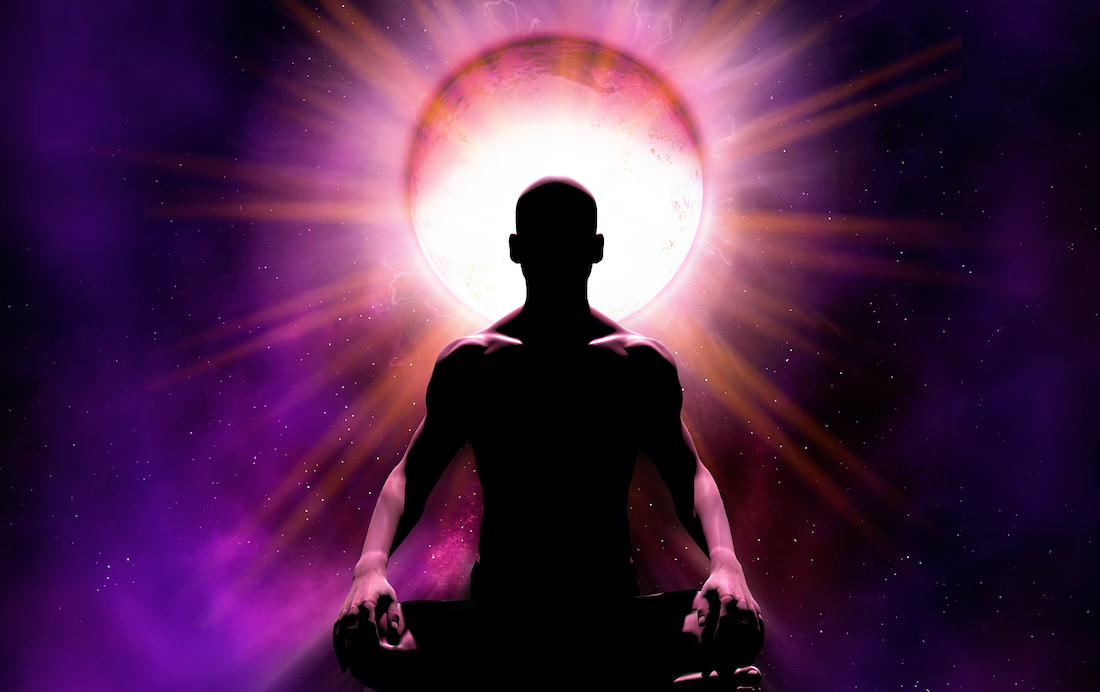 WHAT IS MEDITATION?
WHAT IS MEDITATION? PART ONE ABOUT MEDITATION. WHAT IS MEDITATION? WITNESSING IS THE SPIRIT OF MEDITATION Meditation is an adventure, the greatest adventure the human mind is capable of. To meditate is simply to be, without generating anything—no action, no thought, no emotion. you
PART FOUR OBSTACLES TO MEDITATION
PART FOUR OBSTACLES TO MEDITATION TWO DIFFICULTIES On the path of meditation, there are only two difficulties: the first is the ego. Society, family, school, church, people around you are constantly accustoming you to the life of an egoist. Even modern psychology is based on amplification
The nature of meditation
The Nature of Meditation Meditation is unity - it makes the separated components of a person become one. When you say that your body and your mind or your mind and your soul are different things, you are dividing yourself.